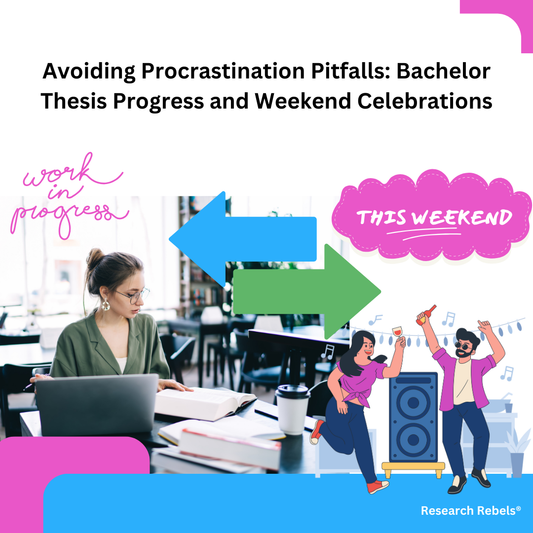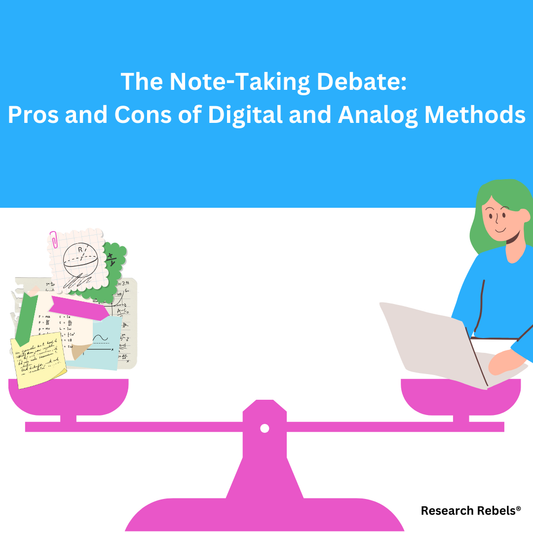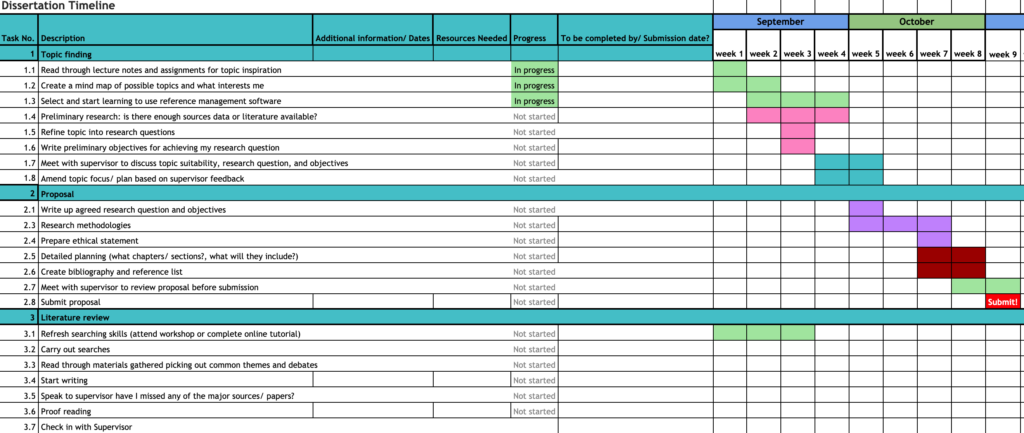- Thesis Action Plan New
- Academic Project Planner

Literature Navigator
Thesis dialogue blueprint, writing wizard's template, research proposal compass.
- Why students love us
- Why professors love us
- Rebels Blog (Free)
- Why we are different
- All Products
- Coming Soon
The 30-Day Thesis Challenge: Your Roadmap to Writing it in Under a Month

Embarking on a thesis can be a daunting endeavor, especially when time is of the essence. The 30-Day Thesis Challenge is designed to guide students through the process of writing their thesis in under a month, providing a structured approach to tackle this significant academic milestone. This challenge is not just about speed; it's about efficiency, clarity, and maintaining quality while managing time constraints. It's tailored for those who are ready to commit to a focused and disciplined month of thesis writing, with the end goal of producing a comprehensive and well-argued piece of research.
Key Takeaways
- A strategic approach to thesis writing, including understanding requirements and setting milestones, is crucial for success within a tight timeframe.
- Efficient research, utilizing academic databases and effectively synthesizing information, is foundational to developing a relevant and robust thesis.
- Mastering thesis composition involves structuring the thesis effectively, developing a cohesive argument, and refining the academic tone.
- The revision process, including incorporating feedback and self-editing, is essential for refining and finalizing the thesis for submission.
- Effective time management and overcoming procrastination are key to maintaining motivation and managing stress throughout the 30-day challenge.
Devising a Strategic Approach to Thesis Writing
Understanding the scope and requirements.
Embarking on your thesis journey begins with a clear understanding of the scope and requirements of your project. This foundational step is crucial as it sets the parameters within which your research will operate. A well-defined scope statement provides basic information about the depth and breadth of your project, ensuring that you have a focused approach to your research. Identify the key elements of your thesis, including the research question, objectives, and the methodology you plan to use.
Next, familiarize yourself with the specific requirements set by your academic institution. These may include formatting guidelines, submission deadlines, and any necessary ethical approvals. To streamline this process, consider creating a checklist of these requirements to ensure nothing is overlooked. Here's an example of what your checklist might include:
- Research question and objectives
- Methodology and tools
- Institutional guidelines
- Ethical approval (if applicable)
- Submission deadlines
By taking these initial steps seriously, you lay a solid foundation for the rest of your thesis work, positioning yourself for a successful and timely completion.
Creating a Detailed Work Plan
A detailed work plan is the backbone of your thesis writing process. It acts as a project roadmap before the major work begins, outlining the research you plan to complete and providing background and context. Start by breaking down your thesis into smaller, manageable sections and assign a timeframe to each. Ensure that each task is realistic and achievable within the set period.
Consider the following steps to create your work plan:
- Identify the key chapters and sections of your thesis.
- Estimate the time required for research, writing, and revision for each section.
- Allocate time for unexpected challenges or additional research.
- Schedule regular meetings with your supervisor for progress updates and feedback.
By investigating procedures and steps, you can anticipate potential obstacles and incorporate solutions into your plan. Remember, a well-structured work plan is crucial for maintaining momentum and focus throughout your thesis journey.
Setting Achievable Milestones
To ensure the success of your thesis within the ambitious timeframe of 30 days, it is crucial to set achievable milestones. These milestones will serve as checkpoints to measure your progress and keep you on track. Begin by breaking down your thesis into smaller, manageable tasks. Each task should have a clear objective and a defined completion date, adhering to the SMART criteria —Specific, Measurable, Achievable, Relevant, and Time-Based.
For instance, you might set a milestone to complete the literature review within the first week. This involves identifying key literature, synthesizing relevant information, and integrating it into your thesis framework. As you progress, regularly review and adjust your milestones to reflect any changes in your research or writing process. Remember, the goal is to maintain a steady pace without compromising the quality of your work.
Here's an example of how you might structure your milestones:
- Week 1: Finalize research question and complete literature review.
- Week 2: Collect and analyze data.
- Week 3: Write the main chapters of the thesis.
- Week 4: Revise, seek feedback, and prepare for submission.
By setting clear goals and milestones , you develop research and writing skills essential for a successful thesis completion. Moreover, seeking guidance and support when needed can provide additional assurance that you are on the right path.
Conducting Comprehensive Research Efficiently
Utilizing academic databases and resources.
Embarking on your thesis journey requires a solid foundation of resources. Identify relevant disciplinary databases to ensure a comprehensive literature search. Academic databases such as JSTOR, PubMed, and IEEE Xplore offer a wealth of peer-reviewed articles, books, and conference papers that are indispensable for your research.
To streamline your search process, consider using tools like the Thesis Action Plan and specialized worksheets. These resources can help you organize your findings and develop effective research strategies. For instance, a Literature Navigator can assist in tracking your sources, while a Research Proposal Compass can guide the structuring of your proposal.
Remember, a well-organized approach to utilizing academic databases will save you time and enhance the quality of your thesis. Below is a list of steps to maximize the use of these resources:
- Begin by defining your research topic and keywords.
- Search multidisciplinary databases for a broad scope of literature.
- Use journal rankings to identify authoritative sources.
- Contact database support for assistance with advanced search features.
- Connect with peers and professors for additional resource recommendations.
Organizing Literature and Notes
As you embark on the thesis writing journey, organizing your literature and notes is a pivotal step. Begin by gathering research materials that support your thesis, ensuring you have a robust foundation for your argument. It's crucial to order your sources in a way that reflects the development of your topic, possibly by publication chronology or by trends that highlight significant shifts in the field.
To maintain a clear overview of your resources, consider using tools like a Literature Navigator or creating a custom literature matrix. Here's an example of how to structure your literature matrix:
| Author | Year | Key Findings | Relevance to Thesis |
|---|---|---|---|
| Smith | 2020 | Finding 1 | Directly related |
| Doe | 2019 | Finding 2 | Indirectly related |
Employing time-blocking techniques and freewriting sessions can enhance your productivity, allowing you to synthesize information efficiently. Remember, a well-organized literature review is not just a summary but a critical discussion that directly ties into your thesis.
Synthesizing Information for Thesis Relevance
Synthesizing information is a critical step in thesis writing where you integrate various sources to support your argument. Focus your article by avoiding tangents and ensuring that each paragraph zeroes in on a single idea. This approach aligns with the advice from the 'Sage Open Guide for Authors' to keep to one problem or a closely related set of problems, enhancing the relevance of your thesis.
When integrating sources, it's essential to have a clear topic sentence that encapsulates the main idea. Following the guidance from 'How to Synthesize and Analyze - Writing Resources', you should combine sources that focus on one idea into a single paragraph, demonstrating how each source contributes to the overarching thesis. This method not only strengthens your argument but also maintains a coherent and focused narrative throughout your work.
To ensure that your synthesis is effective, consider the following steps:
- Identify key themes and patterns in the literature.
- Determine how each source relates to your thesis statement.
- Organize your writing to build a cohesive argument.
- Use italics for emphasis when introducing pivotal concepts or terms.
By meticulously synthesizing information, you create a solid foundation for your thesis, ensuring that every piece of evidence is purposefully chosen and clearly connected to your central argument.
Mastering the Art of Thesis Composition
Structuring your thesis effectively.
To structure your thesis effectively, begin by outlining the main sections: introduction, literature review, methodology, results, discussion, and conclusion. Each section should serve a distinct purpose , contributing to the overall argument of your thesis. The introduction sets the stage, presenting your research question and the significance of your study. The literature review situates your work within the existing body of knowledge, while the methodology explains how you conducted your research.
In the results section, present your findings in a clear and logical manner. Use tables or figures if they help clarify your data. The discussion interprets the results, linking them back to your research question and the literature you reviewed. Finally, the conclusion summarizes your findings, discusses the implications, and suggests areas for future research. Remember to set realistic deadlines for each section to maintain a steady pace towards completion.
By adhering to this structure, you ensure that your thesis is not only well-organized but also compelling. It's essential to maintain a cohesive narrative throughout, making it easier for your readers to follow your line of reasoning. As you delve into the writing process, keep in mind the effective school characteristics and leadership qualities that can influence your work's impact and relevance.
Developing a Cohesive Argument
To develop a cohesive argument, you must ensure that each point you make is interconnected and directly supports your thesis statement. Start by asking yourself a yes or no question about your topic to establish an assertive thesis statement. This approach helps in maintaining focus and ensuring that your argument remains on track.
When structuring paragraphs, prioritize your most relevant and important information . This not only strengthens the clarity of your argument but also guides the reader through your line of reasoning with greater ease. Use cohesion to join ideas and points, ensuring that everything you include is relevant to the main argument of your paragraph.
Below is a list of strategies to enhance the cohesion of your argument:
- Clearly define your thesis statement.
- Use topic sentences to preview the content of each paragraph.
- Employ transitional phrases to link ideas smoothly.
- Refer back to your thesis regularly to maintain direction.
- Synthesize, don't just summarize, information from your sources.
Refining Language and Academic Tone
As you delve into the final stages of your thesis composition, refining the language and academic tone becomes paramount. Your writing should be direct and concise , avoiding wordiness to ensure clarity and precision. This is not merely about choosing the right words; it's about sculpting your narrative to be as effective and impactful as possible.
To achieve an academic writing style , consider the following points:
- Employ a formal tone, steering clear of colloquialisms and slang.
- Use active voice to convey your ideas more directly.
- Be meticulous with grammar, punctuation, and syntax to enhance readability.
- Vary sentence structure to maintain reader engagement and emphasize key points.
Remember, the goal is to communicate your research findings in a manner that resonates with your academic audience. Tools for thesis writing and academic project planning can be invaluable in this process, offering structured support as you refine your work. Additionally, maintaining a social life is crucial for your well-being, providing necessary breaks and perspective during the intensive writing phase.
Navigating the Revision and Feedback Process
Incorporating supervisor and peer feedback.
Receiving feedback from your supervisor and peers is a critical step in refining your thesis. It's essential to approach this process with an open mind and a willingness to engage in constructive dialogue . Begin by organizing the feedback you've received; categorize comments by theme or chapter to streamline the revision process. Prioritize the feedback based on its impact on your thesis's overall quality and coherence.
When discussing feedback with your supervisor, be proactive. Prepare questions and seek clarification on any points that are unclear. It's important to understand the rationale behind their suggestions to make informed decisions about your revisions. If you're considering co-authorship with your supervisor, it's crucial to have a candid conversation about their contributions and expectations. Communication is key to ensuring that both parties are acknowledged appropriately.
Incorporate the feedback systematically, addressing the most significant issues first. Use the following list as a guide to track your progress:
- Address major concerns related to research findings and argumentation.
- Revise sections where clarity and coherence can be improved.
- Update references and ensure proper citation as per feedback.
- Fine-tune the language and academic tone throughout the thesis.
Remember, feedback is not just about making corrections; it's an opportunity to enhance the scholarly value of your work. Embrace it as a vital part of your thesis journey.
Critical Review and Self-Editing Techniques
Embarking on the critical review and self-editing phase of your thesis can be a transformative process. It is essential to approach all revisions with a clear mind and a willingness to refine your work. Start by focusing on one issue at a time, ensuring thoroughness in your revisions. This methodical approach will help you maintain clarity and coherence throughout your document.
Effective self-editing involves more than just proofreading for grammar and spelling errors; it requires a critical eye for consistency in argumentation and structure. Utilize tools such as the Thesis Action Plan to guide your editing process, ensuring that each section of your thesis aligns with your overall objective. Below is a list of key self-editing steps to consider:
- Review your thesis structure for logical flow.
- Check for clarity in your argumentation and evidence.
- Ensure that your language is academic yet accessible.
- Verify all citations and references are correctly formatted.
- Eliminate any redundant or irrelevant information.
Remember, self-editing is an iterative process. It may require multiple rounds of review to achieve the desired level of polish. Seek feedback from peers or supervisors to gain different perspectives on your work, and be open to their suggestions for improvement.
Finalizing the Thesis for Submission
As you approach the culmination of your thesis journey, it's essential to ensure that your document is meticulously reviewed and formatted according to your institution's guidelines. Finalizing your thesis for submission involves a thorough check of all elements, from the title page to the appendices. Ensure that your citations and references are correctly formatted and that your document adheres to the required academic style.
Before submission, it's advisable to have your thesis reviewed by peers or mentors who can provide valuable insights. This step is crucial in identifying any areas that may need improvement or clarification. Once you've incorporated their feedback and polished your thesis to its finest, you're ready to submit. Here's a simple checklist to guide you through the final stages:
- Confirm that all sections are complete and in order
- Check for consistency in formatting and style
- Review grammar and spelling
- Verify that all citations and references are accurate
- Obtain final approval from your supervisor
Reflect on your achievement and the hard work you've invested. After thesis presentation, consider the feedback received and refine your thesis further if necessary. This is also an opportune moment to explore publishing opportunities, which can significantly contribute to your professional development.
Time Management and Overcoming Procrastination
Prioritizing tasks and allocating time wisely.
In the quest to write your thesis within 30 days, effective time management is your most powerful ally. Begin by breaking down your thesis into smaller, more manageable tasks. This approach not only clarifies what needs to be accomplished but also provides a sense of progress as you complete each segment. Consider employing a digital tool like Todoist to organize your tasks. With Todoist, you can assign due dates to each chapter task, ensuring that your work aligns with your overall timeline and keeps you on track.
To further streamline your efforts, categorize tasks by priority. High-priority tasks should align closely with your thesis milestones, while lower-priority tasks can be scheduled around these critical points. Here's a simple list to guide you:
- Identify and prioritize tasks that have the greatest impact on your thesis progression.
- Assign realistic deadlines to each task, allowing for flexibility where necessary.
- Regularly review and adjust your plan to reflect any changes in your research or writing process.
By adhering to these steps, you'll maintain focus and momentum, moving steadily towards your goal of completing your thesis in under a month.
Employing Productivity Tools and Techniques
In the quest to write your thesis within 30 days, harnessing the power of productivity tools and techniques is indispensable. Utilize project management tools to keep track of your progress, deadlines, and tasks. These tools can help you visualize your thesis journey and ensure that you stay on course. Effective study routines are also crucial; they create a rhythm that can enhance focus and efficiency.
To minimize distractions , consider time blocking techniques, dedicating specific hours of your day exclusively to thesis work. This method not only helps in maintaining a clear boundary between work and leisure but also instills a sense of urgency and focus during those designated times. Remember, the key to successful thesis writing involves prioritizing tasks and allocating dedicated time for each segment of your work.
Lastly, don't underestimate the importance of taking breaks. Regular intervals of rest can rejuvenate your mind, allowing for sustained concentration and a fresh perspective upon returning to your work. Employing these productivity techniques and technology tools can significantly boost your organization and efficiency, propelling you towards a timely and successful thesis submission.
Maintaining Motivation and Managing Stress
Embarking on the thesis journey can be as taxing mentally as it is academically. To maintain motivation and manage stress, it's crucial to set clear goals and create a schedule that includes regular breaks for self-care. Effective time management is not just about working hard; it's about working smart, prioritizing tasks, and ensuring you have time for relaxation and reflection.
Employing productivity tools can streamline your workflow, but don't overlook the importance of seeking support when needed. Engage with peers, join study groups, or seek guidance from mentors. These interactions can provide fresh perspectives and emotional encouragement. Additionally, continuous evaluation of your strategies allows you to adjust your approach, ensuring you remain on track without becoming overwhelmed.
Lastly, recognize your achievements, no matter how small. This recognition serves as a powerful motivator, reminding you of the progress you've made. Celebrate each milestone to fuel your journey forward, and remember, control over your thesis process is a significant factor in reducing anxiety and boosting motivation.
Struggling with time management and the daunting task of overcoming procrastination? You're not alone. At Research Rebels, we specialize in transforming thesis anxiety and sleepless nights into a structured, stress-free academic journey. Our step-by-step Thesis Action Plan is designed to guide you through every phase of your thesis, ensuring you stay on track and meet your deadlines with confidence. Don't let procrastination hold you back any longer. Visit our website now to claim your special offer and take the first step towards academic success with ease and clarity.
In conclusion, the 30-Day Thesis Challenge presents a structured and intensive approach to thesis writing that can significantly streamline the process. By following a daily roadmap and utilizing strategic planning, students can overcome the common hurdles of thesis anxiety and time constraints. The challenge emphasizes the importance of a holistic approach, integrating tools such as the Thesis Action Plan and various worksheets to ensure a comprehensive understanding of each step. It is crucial to remember that while the challenge is ambitious, it is also a flexible framework that can be adapted to individual needs and circumstances. Ultimately, the 30-Day Thesis Challenge is not just about completing a thesis swiftly; it's about cultivating the skills and confidence necessary for academic success. Embracing this challenge can transform the daunting task of thesis writing into an achievable and even enjoyable journey.
Frequently Asked Questions
Can i really write my thesis in 30 days.
Yes, with a strategic approach, efficient research, effective writing, and time management, it is possible to write your thesis in 30 days. Following a detailed plan like the one outlined in the 30-Day Thesis Challenge can help you stay on track.
How do I manage the vast amount of research for my thesis?
Utilize academic databases and resources to conduct comprehensive research efficiently. Organize your literature and notes systematically and synthesize information to ensure relevance to your thesis.
What are the key elements of a well-structured thesis?
A well-structured thesis should have a clear introduction, a detailed methodology, a comprehensive literature review, well-presented results, and a conclusive discussion. Each section should support the development of your cohesive argument.
How important is feedback during the thesis writing process?
Feedback is crucial. It provides external perspectives on your work, helping you refine your argument and composition. Incorporate feedback from your supervisor and peers, and use critical review and self-editing techniques to improve your thesis.
What strategies can I use to avoid procrastination?
Prioritize tasks, allocate time wisely, and set realistic deadlines. Employ productivity tools and techniques such as the Pomodoro Technique or time-blocking. Stay motivated by setting small goals and rewarding yourself upon achieving them.
Is it acceptable to seek professional help for thesis writing?
Yes, many students seek professional help for aspects like proofreading, editing, or writing assistance. However, ensure that the work remains your own and that any external help complies with your institution's academic integrity policies.

AI for Academia: Revolutionizing Research and Learning
How do you write a hypothesis step-by-step instructions, how to write a bachelor thesis: tips and tricks, how to write the best dissertation: a comprehensive guide, help with your master thesis: essential resources and advice.

Demystifying Research: Understanding the Difference Between a Problem and a Hypothesis

Avoiding Procrastination Pitfalls: Bachelor Thesis Progress and Weekend Celebrations

How Do You Write a Hypothesis for a Research Paper? Step-by-Step Guide

How to Write a Thesis Fast: Tips and Strategies for Success

The Note-Taking Debate: Pros and Cons of Digital and Analog Methods

Thesis Action Plan

- Rebels Blog
- Blog Articles
- Terms and Conditions
- Payment and Shipping Terms
- Privacy Policy
- Return Policy
© 2024 Research Rebels, All rights reserved.
Your cart is currently empty.
How To Write A Dissertation Or Thesis
8 straightforward steps to craft an a-grade dissertation.
By: Derek Jansen (MBA) Expert Reviewed By: Dr Eunice Rautenbach | June 2020
Writing a dissertation or thesis is not a simple task. It takes time, energy and a lot of will power to get you across the finish line. It’s not easy – but it doesn’t necessarily need to be a painful process. If you understand the big-picture process of how to write a dissertation or thesis, your research journey will be a lot smoother.
In this post, I’m going to outline the big-picture process of how to write a high-quality dissertation or thesis, without losing your mind along the way. If you’re just starting your research, this post is perfect for you. Alternatively, if you’ve already submitted your proposal, this article which covers how to structure a dissertation might be more helpful.
How To Write A Dissertation: 8 Steps
- Clearly understand what a dissertation (or thesis) is
- Find a unique and valuable research topic
- Craft a convincing research proposal
- Write up a strong introduction chapter
- Review the existing literature and compile a literature review
- Design a rigorous research strategy and undertake your own research
- Present the findings of your research
- Draw a conclusion and discuss the implications

Step 1: Understand exactly what a dissertation is
This probably sounds like a no-brainer, but all too often, students come to us for help with their research and the underlying issue is that they don’t fully understand what a dissertation (or thesis) actually is.
So, what is a dissertation?
At its simplest, a dissertation or thesis is a formal piece of research , reflecting the standard research process . But what is the standard research process, you ask? The research process involves 4 key steps:
- Ask a very specific, well-articulated question (s) (your research topic)
- See what other researchers have said about it (if they’ve already answered it)
- If they haven’t answered it adequately, undertake your own data collection and analysis in a scientifically rigorous fashion
- Answer your original question(s), based on your analysis findings

In short, the research process is simply about asking and answering questions in a systematic fashion . This probably sounds pretty obvious, but people often think they’ve done “research”, when in fact what they have done is:
- Started with a vague, poorly articulated question
- Not taken the time to see what research has already been done regarding the question
- Collected data and opinions that support their gut and undertaken a flimsy analysis
- Drawn a shaky conclusion, based on that analysis
If you want to see the perfect example of this in action, look out for the next Facebook post where someone claims they’ve done “research”… All too often, people consider reading a few blog posts to constitute research. Its no surprise then that what they end up with is an opinion piece, not research. Okay, okay – I’ll climb off my soapbox now.
The key takeaway here is that a dissertation (or thesis) is a formal piece of research, reflecting the research process. It’s not an opinion piece , nor a place to push your agenda or try to convince someone of your position. Writing a good dissertation involves asking a question and taking a systematic, rigorous approach to answering it.
If you understand this and are comfortable leaving your opinions or preconceived ideas at the door, you’re already off to a good start!

Step 2: Find a unique, valuable research topic
As we saw, the first step of the research process is to ask a specific, well-articulated question. In other words, you need to find a research topic that asks a specific question or set of questions (these are called research questions ). Sounds easy enough, right? All you’ve got to do is identify a question or two and you’ve got a winning research topic. Well, not quite…
A good dissertation or thesis topic has a few important attributes. Specifically, a solid research topic should be:
Let’s take a closer look at these:
Attribute #1: Clear
Your research topic needs to be crystal clear about what you’re planning to research, what you want to know, and within what context. There shouldn’t be any ambiguity or vagueness about what you’ll research.
Here’s an example of a clearly articulated research topic:
An analysis of consumer-based factors influencing organisational trust in British low-cost online equity brokerage firms.
As you can see in the example, its crystal clear what will be analysed (factors impacting organisational trust), amongst who (consumers) and in what context (British low-cost equity brokerage firms, based online).
Need a helping hand?
Attribute #2: Unique
Your research should be asking a question(s) that hasn’t been asked before, or that hasn’t been asked in a specific context (for example, in a specific country or industry).
For example, sticking organisational trust topic above, it’s quite likely that organisational trust factors in the UK have been investigated before, but the context (online low-cost equity brokerages) could make this research unique. Therefore, the context makes this research original.
One caveat when using context as the basis for originality – you need to have a good reason to suspect that your findings in this context might be different from the existing research – otherwise, there’s no reason to warrant researching it.
Attribute #3: Important
Simply asking a unique or original question is not enough – the question needs to create value. In other words, successfully answering your research questions should provide some value to the field of research or the industry. You can’t research something just to satisfy your curiosity. It needs to make some form of contribution either to research or industry.
For example, researching the factors influencing consumer trust would create value by enabling businesses to tailor their operations and marketing to leverage factors that promote trust. In other words, it would have a clear benefit to industry.
So, how do you go about finding a unique and valuable research topic? We explain that in detail in this video post – How To Find A Research Topic . Yeah, we’ve got you covered 😊
Step 3: Write a convincing research proposal
Once you’ve pinned down a high-quality research topic, the next step is to convince your university to let you research it. No matter how awesome you think your topic is, it still needs to get the rubber stamp before you can move forward with your research. The research proposal is the tool you’ll use for this job.
So, what’s in a research proposal?
The main “job” of a research proposal is to convince your university, advisor or committee that your research topic is worthy of approval. But convince them of what? Well, this varies from university to university, but generally, they want to see that:
- You have a clearly articulated, unique and important topic (this might sound familiar…)
- You’ve done some initial reading of the existing literature relevant to your topic (i.e. a literature review)
- You have a provisional plan in terms of how you will collect data and analyse it (i.e. a methodology)
At the proposal stage, it’s (generally) not expected that you’ve extensively reviewed the existing literature , but you will need to show that you’ve done enough reading to identify a clear gap for original (unique) research. Similarly, they generally don’t expect that you have a rock-solid research methodology mapped out, but you should have an idea of whether you’ll be undertaking qualitative or quantitative analysis , and how you’ll collect your data (we’ll discuss this in more detail later).
Long story short – don’t stress about having every detail of your research meticulously thought out at the proposal stage – this will develop as you progress through your research. However, you do need to show that you’ve “done your homework” and that your research is worthy of approval .
So, how do you go about crafting a high-quality, convincing proposal? We cover that in detail in this video post – How To Write A Top-Class Research Proposal . We’ve also got a video walkthrough of two proposal examples here .
Step 4: Craft a strong introduction chapter
Once your proposal’s been approved, its time to get writing your actual dissertation or thesis! The good news is that if you put the time into crafting a high-quality proposal, you’ve already got a head start on your first three chapters – introduction, literature review and methodology – as you can use your proposal as the basis for these.
Handy sidenote – our free dissertation & thesis template is a great way to speed up your dissertation writing journey.
What’s the introduction chapter all about?
The purpose of the introduction chapter is to set the scene for your research (dare I say, to introduce it…) so that the reader understands what you’ll be researching and why it’s important. In other words, it covers the same ground as the research proposal in that it justifies your research topic.
What goes into the introduction chapter?
This can vary slightly between universities and degrees, but generally, the introduction chapter will include the following:
- A brief background to the study, explaining the overall area of research
- A problem statement , explaining what the problem is with the current state of research (in other words, where the knowledge gap exists)
- Your research questions – in other words, the specific questions your study will seek to answer (based on the knowledge gap)
- The significance of your study – in other words, why it’s important and how its findings will be useful in the world
As you can see, this all about explaining the “what” and the “why” of your research (as opposed to the “how”). So, your introduction chapter is basically the salesman of your study, “selling” your research to the first-time reader and (hopefully) getting them interested to read more.
How do I write the introduction chapter, you ask? We cover that in detail in this post .

Step 5: Undertake an in-depth literature review
As I mentioned earlier, you’ll need to do some initial review of the literature in Steps 2 and 3 to find your research gap and craft a convincing research proposal – but that’s just scratching the surface. Once you reach the literature review stage of your dissertation or thesis, you need to dig a lot deeper into the existing research and write up a comprehensive literature review chapter.
What’s the literature review all about?
There are two main stages in the literature review process:
Literature Review Step 1: Reading up
The first stage is for you to deep dive into the existing literature (journal articles, textbook chapters, industry reports, etc) to gain an in-depth understanding of the current state of research regarding your topic. While you don’t need to read every single article, you do need to ensure that you cover all literature that is related to your core research questions, and create a comprehensive catalogue of that literature , which you’ll use in the next step.
Reading and digesting all the relevant literature is a time consuming and intellectually demanding process. Many students underestimate just how much work goes into this step, so make sure that you allocate a good amount of time for this when planning out your research. Thankfully, there are ways to fast track the process – be sure to check out this article covering how to read journal articles quickly .

Literature Review Step 2: Writing up
Once you’ve worked through the literature and digested it all, you’ll need to write up your literature review chapter. Many students make the mistake of thinking that the literature review chapter is simply a summary of what other researchers have said. While this is partly true, a literature review is much more than just a summary. To pull off a good literature review chapter, you’ll need to achieve at least 3 things:
- You need to synthesise the existing research , not just summarise it. In other words, you need to show how different pieces of theory fit together, what’s agreed on by researchers, what’s not.
- You need to highlight a research gap that your research is going to fill. In other words, you’ve got to outline the problem so that your research topic can provide a solution.
- You need to use the existing research to inform your methodology and approach to your own research design. For example, you might use questions or Likert scales from previous studies in your your own survey design .
As you can see, a good literature review is more than just a summary of the published research. It’s the foundation on which your own research is built, so it deserves a lot of love and attention. Take the time to craft a comprehensive literature review with a suitable structure .
But, how do I actually write the literature review chapter, you ask? We cover that in detail in this video post .
Step 6: Carry out your own research
Once you’ve completed your literature review and have a sound understanding of the existing research, its time to develop your own research (finally!). You’ll design this research specifically so that you can find the answers to your unique research question.
There are two steps here – designing your research strategy and executing on it:
1 – Design your research strategy
The first step is to design your research strategy and craft a methodology chapter . I won’t get into the technicalities of the methodology chapter here, but in simple terms, this chapter is about explaining the “how” of your research. If you recall, the introduction and literature review chapters discussed the “what” and the “why”, so it makes sense that the next point to cover is the “how” –that’s what the methodology chapter is all about.
In this section, you’ll need to make firm decisions about your research design. This includes things like:
- Your research philosophy (e.g. positivism or interpretivism )
- Your overall methodology (e.g. qualitative , quantitative or mixed methods)
- Your data collection strategy (e.g. interviews , focus groups, surveys)
- Your data analysis strategy (e.g. content analysis , correlation analysis, regression)
If these words have got your head spinning, don’t worry! We’ll explain these in plain language in other posts. It’s not essential that you understand the intricacies of research design (yet!). The key takeaway here is that you’ll need to make decisions about how you’ll design your own research, and you’ll need to describe (and justify) your decisions in your methodology chapter.
2 – Execute: Collect and analyse your data
Once you’ve worked out your research design, you’ll put it into action and start collecting your data. This might mean undertaking interviews, hosting an online survey or any other data collection method. Data collection can take quite a bit of time (especially if you host in-person interviews), so be sure to factor sufficient time into your project plan for this. Oftentimes, things don’t go 100% to plan (for example, you don’t get as many survey responses as you hoped for), so bake a little extra time into your budget here.
Once you’ve collected your data, you’ll need to do some data preparation before you can sink your teeth into the analysis. For example:
- If you carry out interviews or focus groups, you’ll need to transcribe your audio data to text (i.e. a Word document).
- If you collect quantitative survey data, you’ll need to clean up your data and get it into the right format for whichever analysis software you use (for example, SPSS, R or STATA).
Once you’ve completed your data prep, you’ll undertake your analysis, using the techniques that you described in your methodology. Depending on what you find in your analysis, you might also do some additional forms of analysis that you hadn’t planned for. For example, you might see something in the data that raises new questions or that requires clarification with further analysis.
The type(s) of analysis that you’ll use depend entirely on the nature of your research and your research questions. For example:
- If your research if exploratory in nature, you’ll often use qualitative analysis techniques .
- If your research is confirmatory in nature, you’ll often use quantitative analysis techniques
- If your research involves a mix of both, you might use a mixed methods approach
Again, if these words have got your head spinning, don’t worry! We’ll explain these concepts and techniques in other posts. The key takeaway is simply that there’s no “one size fits all” for research design and methodology – it all depends on your topic, your research questions and your data. So, don’t be surprised if your study colleagues take a completely different approach to yours.

Step 7: Present your findings
Once you’ve completed your analysis, it’s time to present your findings (finally!). In a dissertation or thesis, you’ll typically present your findings in two chapters – the results chapter and the discussion chapter .
What’s the difference between the results chapter and the discussion chapter?
While these two chapters are similar, the results chapter generally just presents the processed data neatly and clearly without interpretation, while the discussion chapter explains the story the data are telling – in other words, it provides your interpretation of the results.
For example, if you were researching the factors that influence consumer trust, you might have used a quantitative approach to identify the relationship between potential factors (e.g. perceived integrity and competence of the organisation) and consumer trust. In this case:
- Your results chapter would just present the results of the statistical tests. For example, correlation results or differences between groups. In other words, the processed numbers.
- Your discussion chapter would explain what the numbers mean in relation to your research question(s). For example, Factor 1 has a weak relationship with consumer trust, while Factor 2 has a strong relationship.
Depending on the university and degree, these two chapters (results and discussion) are sometimes merged into one , so be sure to check with your institution what their preference is. Regardless of the chapter structure, this section is about presenting the findings of your research in a clear, easy to understand fashion.
Importantly, your discussion here needs to link back to your research questions (which you outlined in the introduction or literature review chapter). In other words, it needs to answer the key questions you asked (or at least attempt to answer them).
For example, if we look at the sample research topic:
In this case, the discussion section would clearly outline which factors seem to have a noteworthy influence on organisational trust. By doing so, they are answering the overarching question and fulfilling the purpose of the research .

For more information about the results chapter , check out this post for qualitative studies and this post for quantitative studies .
Step 8: The Final Step Draw a conclusion and discuss the implications
Last but not least, you’ll need to wrap up your research with the conclusion chapter . In this chapter, you’ll bring your research full circle by highlighting the key findings of your study and explaining what the implications of these findings are.
What exactly are key findings? The key findings are those findings which directly relate to your original research questions and overall research objectives (which you discussed in your introduction chapter). The implications, on the other hand, explain what your findings mean for industry, or for research in your area.
Sticking with the consumer trust topic example, the conclusion might look something like this:
Key findings
This study set out to identify which factors influence consumer-based trust in British low-cost online equity brokerage firms. The results suggest that the following factors have a large impact on consumer trust:
While the following factors have a very limited impact on consumer trust:
Notably, within the 25-30 age groups, Factors E had a noticeably larger impact, which may be explained by…
Implications
The findings having noteworthy implications for British low-cost online equity brokers. Specifically:
The large impact of Factors X and Y implies that brokers need to consider….
The limited impact of Factor E implies that brokers need to…
As you can see, the conclusion chapter is basically explaining the “what” (what your study found) and the “so what?” (what the findings mean for the industry or research). This brings the study full circle and closes off the document.

Let’s recap – how to write a dissertation or thesis
You’re still with me? Impressive! I know that this post was a long one, but hopefully you’ve learnt a thing or two about how to write a dissertation or thesis, and are now better equipped to start your own research.
To recap, the 8 steps to writing a quality dissertation (or thesis) are as follows:
- Understand what a dissertation (or thesis) is – a research project that follows the research process.
- Find a unique (original) and important research topic
- Craft a convincing dissertation or thesis research proposal
- Write a clear, compelling introduction chapter
- Undertake a thorough review of the existing research and write up a literature review
- Undertake your own research
- Present and interpret your findings
Once you’ve wrapped up the core chapters, all that’s typically left is the abstract , reference list and appendices. As always, be sure to check with your university if they have any additional requirements in terms of structure or content.

Psst... there’s more!
This post was based on one of our popular Research Bootcamps . If you're working on a research project, you'll definitely want to check this out ...
You Might Also Like:

20 Comments
thankfull >>>this is very useful
Thank you, it was really helpful
unquestionably, this amazing simplified way of teaching. Really , I couldn’t find in the literature words that fully explicit my great thanks to you. However, I could only say thanks a-lot.
Great to hear that – thanks for the feedback. Good luck writing your dissertation/thesis.
This is the most comprehensive explanation of how to write a dissertation. Many thanks for sharing it free of charge.
Very rich presentation. Thank you
Thanks Derek Jansen|GRADCOACH, I find it very useful guide to arrange my activities and proceed to research!
Thank you so much for such a marvelous teaching .I am so convinced that am going to write a comprehensive and a distinct masters dissertation
It is an amazing comprehensive explanation
This was straightforward. Thank you!
I can say that your explanations are simple and enlightening – understanding what you have done here is easy for me. Could you write more about the different types of research methods specific to the three methodologies: quan, qual and MM. I look forward to interacting with this website more in the future.
Thanks for the feedback and suggestions 🙂
Hello, your write ups is quite educative. However, l have challenges in going about my research questions which is below; *Building the enablers of organisational growth through effective governance and purposeful leadership.*
Very educating.
Just listening to the name of the dissertation makes the student nervous. As writing a top-quality dissertation is a difficult task as it is a lengthy topic, requires a lot of research and understanding and is usually around 10,000 to 15000 words. Sometimes due to studies, unbalanced workload or lack of research and writing skill students look for dissertation submission from professional writers.
Thank you 💕😊 very much. I was confused but your comprehensive explanation has cleared my doubts of ever presenting a good thesis. Thank you.
thank you so much, that was so useful
Hi. Where is the excel spread sheet ark?
could you please help me look at your thesis paper to enable me to do the portion that has to do with the specification
my topic is “the impact of domestic revenue mobilization.
Submit a Comment Cancel reply
Your email address will not be published. Required fields are marked *
Save my name, email, and website in this browser for the next time I comment.
- Print Friendly
Want to Get your Dissertation Accepted?
Discover how we've helped doctoral students complete their dissertations and advance their academic careers!
Join 200+ Graduated Students

Get Your Dissertation Accepted On Your Next Submission
Get customized coaching for:.
- Crafting your proposal,
- Collecting and analyzing your data, or
- Preparing your defense.
Trapped in dissertation revisions?
How long does it take to write a dissertation, published by steve tippins on july 11, 2019 july 11, 2019.
Last Updated on: 2nd February 2024, 05:00 am
How long does it take to write a dissertation? The most accurate (and least helpful) answer is, it depends. Since that’s probably not the answer you’re looking for, I’ll use the rest of the article to address the realities of how long it takes to write a dissertation.
How Long Does It Take to Write a Dissertation?
Based on my experience, writing your dissertation should take somewhere between 13-20 months. These are average numbers based upon the scores of doctoral students that I have worked with over the years, and they generally hold true.
I have seen people take less time and more time, but I believe that with concerted effort, the 13-20 month timeframe is reasonable.
“Based on my experience, writing your dissertation should take somewhere between 13-20 months.”
University Requirements
Once you hit the dissertation stage, some schools require a minimum number of hours in the dissertation area before you can graduate. Many schools require the equivalent of one year of dissertation credits to graduate.
So, even if you can finish your dissertation in three months, you will still have to pay for nine more months of dissertation credits before you can graduate. However, unless research and writing is your superpower, I wouldn’t worry about having to pay extra tuition.
But this requirement does offer some insight into how long it takes to write a dissertation. Based on this requirement, it’s reasonable to expect that writing your dissertation will take a year of more. This is consistent with my experience.

However, this timeframe is based on several assumptions. First, I am assuming that you are continually working towards finishing your dissertation. This means that no family emergencies, funding conundrums, or work issues get in the way of completing. Second, there are no major changes in your dissertation committee. Third, you will have access to the data that you need.
Assuming these assumptions hold true, this article should give you a general idea of how long it might take to write your dissertation.
How Long Does it Take to Write A Dissertation? Stage-By-Stage
Let’s break down each stage of the dissertation writing process and how long it takes.
Prospectus
This is the hardest one to judge, as this is where you lay the groundwork for the rest of your dissertation and get buy-in from committee members. Normally this takes from 3-6 months. Not all of this is writing time, though–much of it is spent refining your topic and your approach.
Why does this stage take so long? For many people, starting to express themselves using an academic voice can take time. This can hold up the review process as your committee members ask for writing-related revisions before they even get to evaluating the content. Don’t worry, once you learn the academic language things will start to flow more easily.
One common mistake students make is lack of specificity, both in their writing in general and in their topic focus.
Proposal (Chapters 1-3)

Chapter 1 is often an expansion of your Prospectus. However, you’ll be expected to develop your ideas more and have even more specificity on things like your research question and methodology, so don’t underestimate how long this chapter will take.
Chapter 2 can take some time as you will be digging deep into the literature but I think this can be done in 3-4 months. One caution, some people, and committees, like to start with Chapter 2 so that you are immersed in the literature before completing Chapters 1 and 3. Regardless of where you start, 3-4 months is a good estimate.
Chapter 3 requires an in-depth explanation of your methodology. I suggest working closely with your Chair on this one to avoid multiple submissions and revisions. Get clear on your methodology and make sure you and your chair are on the same page before you write, and continue to check in with your chair, if possible, throughout the process.
IRB Approval
While this step can be full of details and require several iterations it seems that allowing 2 months is sufficient. Most schools have an IRB form that must be submitted. To save time you can usually start filling out the form while your committee is reviewing your Proposal.
Collecting Data
This step varies a great deal. If you are using readily available secondary data this can take a week but if you are interviewing hard to get individuals or have trouble finding a sufficient number of people for your sample this can take 4 months or more. I think 1-4 months should be appropriate
Chapters 4 and 5
These two chapters are the easiest to write as in Chapter 4 you are reporting your results and in Chapter 5 you explain what the results mean. I believe that these two chapters can be written in 2 months.

Defense and Completion
You will need to defend your dissertation and then go through all of the university requirements to finalize the completion of your dissertation. I would allow 2 months for this process.
Variables That Affect How Long It Takes to Write A Dissertation
When students say something like, “I’m going to finish my dissertation in three months,” they likely aren’t considering all of the variables besides the actual writing. Even if you’re a fast writer, you’ll have to wait on your committee’s comments,
Timing Issues
Many schools have response times for committee members. This is important when looking at how long it takes to finish a dissertation. For example, it you have two committee members and they each get up to 2 weeks for a review, it can take up to a month to get a document reviewed, each time you submit. So, plan for these periods of time when thinking about how long that it will take you.
Addressing Comments
How long it takes to write your dissertation also depends on your ability to address your committee’s comments thoroughly. It’s not uncommon for a committee member to send a draft back several times, even if their comments were addressed adequately, because they notice new issues each time they read it. Save yourself considerable time by making sure you address their comments fully, thus avoiding unnecessary time waiting to hear the same feedback.

This is the biggest variable in the dissertation model. How dedicated are you to the process? How much actual time do you have? How many outside interests/requirements do you have? Are you easily distracted? How clean does your workspace need to be? (This may seem like a strange thing to discuss, but many people need to work in a clean space and can get very interested in cleaning if they have to write). Are you in a full-time program or in a part time program? Are you holding down a job? Do you have children?
All of these things will affect how much time you have to put into writing–or rather, how disciplined you need to be about making time to write.
One of the things that can influence how long it takes to write your dissertation is your committee. Choose your committee wisely. If you work under the assumption that the only good dissertation is a done dissertation, then you want a committee that will be helpful and not trying to prove themselves on your back. When you find a Chair that you can work with ask her/him which of their colleagues they work well with (it’s also worth finding out who they don’t work well with).
Find out how they like to receive material to review. Some members like to see pieces of chapters and some like to see completed documents. Once you know their preferences, you can efficiently submit what they want when they want it.
How Long Does it Take to Write a Dissertation? Summary
Barring unforeseen events, the normal time range for finishing a dissertation seems to be 13-19 months, which can be rounded to one to one and a half years. If you are proactive and efficient, you can usually be at the shorter end of the time range.

That means using downtime to do things like changing the tense of your approved Proposal from future tense to past tense and completing things like you Abstract and Acknowledgement sections before final approval.
I hope that you can be efficient in this process and finish as quickly as possible. Remember, “the only good dissertation is a done dissertation.”
On that note, I offer coaching services to help students through the dissertation writing process, as well as editing services for those who need help with their writing.
Steve Tippins
Steve Tippins, PhD, has thrived in academia for over thirty years. He continues to love teaching in addition to coaching recent PhD graduates as well as students writing their dissertations. Learn more about his dissertation coaching and career coaching services. Book a Free Consultation with Steve Tippins
Related Posts

Dissertation
Dissertation memes.
Sometimes you can’t dissertate anymore and you just need to meme. Don’t worry, I’ve got you. Here are some of my favorite dissertation memes that I’ve seen lately. My Favorite Dissertation Memes For when you Read more…

Surviving Post Dissertation Stress Disorder
The process of earning a doctorate can be long and stressful – and for some people, it can even be traumatic. This may be hard for those who haven’t been through a doctoral program to Read more…

PhD by Publication
PhD by publication, also known as “PhD by portfolio” or “PhD by published works,” is a relatively new route to completing your dissertation requirements for your doctoral degree. In the traditional dissertation route, you have Read more…
The Grad Student Way
Your One Stop Grad School and PhD Resource
- Second Income Ebook
- Twitter GradStudentWay
- LinkedIn GradStudentWay
- Facebook Page
- RSS Feed GradStudentWay
- Networking Guide
- Write Your PhD Thesis In One Month Or Less
Thesis/dissertation writing need not be a multi-month ordeal that makes you pull your hair out and roll up into a fetal position. The trick is to get a head start , set goals and deadlines, and work steadily—not feverishly—toward that ultimate satisfaction of handing your magnum opus to the graduate school. The first three sections of this article are devoted to ways that you can get way ahead of the curve from the very beginning of your graduate program—BEFORE push comes to shove.
1.) GET STARTED RIGHT AWAY— YES, REALLY .
NEWS FLASH: you can start working on your thesis or dissertation almost from the moment you decide on a lab/advisor .
In the beginning, there were papers …
The starting point for any newbie graduate student is to read boatloads of relevant papers so that you can learn your advisor’s repertoire of experimental techniques or areas of interest, what has been done so far in the field, what questions remain to be answered, and where your research will contribute.
Keep in mind that these seminal papers will be heavily integrated into your thesis or dissertation:
a) The introduction, in which you give all the pertinent background to set the stage for your research and make everyone on your committee (and beyond!) understand why it’s important
b) Data chapters, where previously published data lend validity to your findings, or are at least taken into consideration as you interpret your data
Let’s back up. How do you find these papers? Hopefully, your advisor will provide you with a few of the original papers that got the ball rolling. Find out what papers cite them . You can perform Boolean searches in Pubmed and Google Scholar (great tips explaining how to do this can be found at Boolean.pdf ).
Note that in Pubmed, you will need to go to “Advanced Search,” where the builder constructs the Boolean search for you (Figure 1). Pubmed offers another great strategy: you can set up citation alerts that notify you via e-mail every time one of these pivotal articles is cited. Pubmed has a tutorial on how to do this here: myncbi.html . You can control how often you receive these alerts, or adjust later based on how inundated your inbox becomes.
FIGURE 1. PubMed’s Boolean Search builder.
Google scholar offers a similar citation alert service. Go to Google Scholar, http://scholar.google.com/ , and click on “Alerts” (see Figure 2). From the next screen, click “Create Alert” (Figure 3). You can set up alerts based on Boolean searches (Figure 4), or by author . Also, since many principal authors have varied interests, you can customize by using a combination Boolean/search-by-author approach (Figure 5). Enter your e-mail address, and you’re good to go.
FIGURE 2. Setting up alerts in Google Scholar. First, click “Alerts.”
FIGURE 3. Setting up alerts in Google Scholar, part 2. Next, click “Create Alert.”
FIGURE 4. Setting up alerts in Google Scholar, part 3. Setting up your search criteria using Boolean operators.
FIGURE 5. Setting up alerts in Google Scholar, part 4. The combined Author/Boolean operator search in Google Scholar.
ORGANIZING your boatloads of papers…
Let’s back up again. Realize that unless you are a genius, you will probably have to revisit these nuggets of wisdom several times during your graduate career, particularly when you have a better grasp on the research. Also, unless you are a genius, you will find yourself wondering, “What was that paper that explained________?” This is where being organized will save you TONS of time.
I am a big fan of saving paper and not printing out reams of articles to be read and then stuffed into filing cabinets . I highly recommend a citation management program, such as Endnote . Find out which program your advisor uses (see if he or she will let you install the program on your computer). Some departments even offer this software free of charge. Not only are all of the citations in your library searchable, but you can also file them into folders based on the subject matter (Figure 6).
FIGURE 6. Filing papers in EndNote–beats a filing cabinet!
As you do your literature search, you download the citations into your citation manager. Most e-journals have a “download to citation manager” link. Google Scholar also recently added a very nice “Cite” function that lets you import citations directly into your citation manager (Figure 7).
FIGURE 7. Google Scholar’s Cite function.
You can also search PubMed from within Endnote, which saves you several steps (Figure 8). In addition, the program has a lovely feature called Cite-While-You-Write that links with Microsoft Word. No more the parenthetical “ need citation !” statements in your text. With the CWYW feature, you can pull up all of the papers in your Endnote library that pertain to your text, and with the click of one button in Word—voilà! Citations inserted (Figure 9)! You can format the bibliography later, when your behemoth is completely written—yet another convenient, automatic feature.
FIGURE 8. Searching for papers from within EndNote.
FIGURE 8. EndNote’s Cite While You Write function.
2) Intermediate documents: the thesis/dissertation proposal and grant applications
Think of your thesis or dissertation proposal and any grant applications as being a big first step toward the first chapter of your final document: the introduction. Preparation of these documents entails a thorough review of pertinent literature to set the stage and explain the rationale for the research you are proposing. So by this logic, you should have taken a very large bite out of the first chapter of your thesis or dissertation by the time you take your preliminary exams.
3) Methods: you do them every day, why not take the time to write them up?
In the STEM fields, theses and dissertations require a chapter devoted to methods. You have your own set of experimental and/or statistical techniques that you presumably learn from your advisor, then troubleshoot and tweak based on your specific needs. You know how you write detailed notes on the conditions of each experiment every time you do them in your lab notebook? (RIGHT?!) This is all information that you can take even an hour per week to write up in your thesis document. Check out the previous papers from your advisor to get ideas on wording, and then re-work it so it’s your own (citing relevant papers, of course). By the time you actually for-real start writing your thesis or dissertation, your methods chapter can be practically done already!
4) After the greenlight…careful planning and sticking to a schedule!
You’ve received the greenlight to “start” writing your thesis or dissertation from your committee. Now what? Well, you have a good chunk of the intro done already, right? Your chapter 2 is practically done as well! Be sure to check out the deadlines not only for getting your document to your committee, but also for depositing it with the graduate school. Wouldn’t it stink to defend your thesis in April, but not graduate until December because you missed the deadline?
Now, I will tell you a huge time-saving tip . Before you start (well, continue) writing, find a colleague who has recently turned in their thesis or dissertation and still has their final word document kicking around . Ask your colleague for permission to use their document in the following way: you are not going to copy anything in that document… EXCEPT THE FORMATTING.
You know the part where the clerk at the grad school pulls out the ruler and measures your margins, page number position and other random stuff while you hold your breath? All of that will already be in your colleague’s word document. Why re-invent the wheel? Just use the document as a template—delete ALL of the text and leave the margins and other formatting alone. (Of course, check over everything carefully before you deposit your document!) Anything you’ve written up to this point can easily be pasted into the template.
Next, agree upon deadlines : “I’ll have chapter 1 to you by________.” If you have been working ahead on your document and your reference library as described above, it should take you about a week to finish up chapter 1 (your introduction) and chapter 2 (methods). Can you do a chapter per week for each of the remaining chapters? Put the deadline in your calendar, and stick to it. Then, based on how much time you are still expected to spend in the lab, decide a set number of hours per day that you will spend on nothing but writing.
I would suggest asking your advisor for blocks of time to hole up at the library, or wherever it is that you do your best work . Then do it. You will be working weekends, no doubt, but try to work steadily and avoid all-nighters. Adjust as necessary—you may need to have an additional meeting with your advisor to request more time away from lab.
Do have a colleague read your document installments before you give them to your advisor . Run spell check and do all the basics before you offer up your baby to the red pen of death. If you really struggle with writing, or if you are not a native English speaker, there are services out there that will clean up your document on a by-the-hour basis. Spare your advisor the frustration of correcting simple errors.
Now, a caveat.
Just because you have a deadline that you are sticking to like an embedded tick does not mean that your advisor will adhere to similar deadlines in getting you edits and feedback . Many advisors, bless their hearts, are procrastinators (erm…busy with grant deadlines, writing their own papers, editing, and other important stuff that advisors do). Don’t sweat it… the ball is now in your advisor’s court, and you will now move steadily on to the next installment.
Which is due by __________in your calendar.
3) BACKUP, BACKUP, BACKUP!
And this time I do mean “backup”—as in your document. There is NO excuse for losing your thesis or dissertation . You should have MULTIPLE copies saved: on your computer, in Dropbox, on an external hard drive, etc. These copies should be clearly marked with dates in case you have to revert back to a prior version. They should also be marked after being edited by your advisor or others.
4) The final weeks
This will be a stressful time unless you are extremely lucky. It usually goes something like this: “Move this section to page 89.” Then two days later: “Put it back where it was.” Your advisor is stressed too—so try to take everything in stride.
If at all possible, try to get your thesis printed off for your committee a day or two in advance . This allows a cushion for the inevitable printer meltdown or copier jam. In my case, I got my final edits at 11 pm the night before my dissertation was due. Luckily, there weren’t a lot of changes to make, and there were no printer fiascos. I finished the edits by midnight and had the whole thing printed off by about 2 in the morning. Although I won’t say that I wasn’t completely stressed out and about to melt down myself…
You want your dissertation to look nice for your committee and to be easy for them to handle and write in . I’m a fan of bindings—I used three ring binders with pockets so that I could also include a CD with a copy of the document. But that’s not for everybody. Spiral bindings are just as good, but again, require planning because you’ll have to take your stack of documents somewhere like FedEx Kinkos. Even though it can be like herding cats to track down all the members of your committee, try to personally deliver your documents to them—not only for security’s sake, but to remind them of who you are.
I kid. Sort of.
5) After the defense
You may have loads of changes to make to your thesis or dissertation based on your committee members’ comments . You feel elated and relieved to have your defense over with. After the effects of the all-night post-defense bender have worn off, try to work diligently on the edits so that you don’t run up against the grad school’s deposit deadline. Make an appointment for a pre-check of your document to catch any formatting errors well in advance of the deadline.
Once you have deposited your thesis or dissertation with the graduate school (congratulations!), investigate how many bound copies you need. Most departments require a bound copy, as will your advisor. Then you need one, of course, and then there’s your parents…
University towns usually have at least one book bindery in addition to services on campus. There are online services as well—but be careful to check their ratings. You generally have to figure up the number of color-copy and high-resolution pages you have versus regular black and white. You send this estimate along with a digital copy of your dissertation and your selections for binding color, lettering, etc. There is something deeply satisfying about finally holding that beautifully bound book—that YOU wrote—in your hands at last.
In summary, it is possible to write your thesis or dissertation in under a month with good preparation, organization, and planning . The end result makes it all worthwhile. Keep in mind that if you move on to a postdoc or any other position that requires writing papers and grants, these same strategies apply.
Further Reading
About the Author:
Search The Grad Student Way
Most recent posts.
- PhD Career Series: Finding and Developing Your Inner Leader
- Top 11 Alternative Entry Level PhD Science Careers To Skip the PostDoc
- PhD Myth Busters: Making the Transition From Academia to Industry
- How A Rock Band Helped Save My PhD
- Is A PhD Really Worth It? Or A Waste of Time?
- Dealing With PhD Stress The Right Way: Advice From 3 PhD Graduates
- PhD Career Series: Product Management
- 5 Ways to Gain Valuable Skills Outside of Your Academic Training
- A PhD Student’s Race Against Time – How To Win/Graduate Faster
- Going Freelance Out of Graduate School
- 10 Ways To Successfully Defend Your PhD
- Considering Grad School? Important Things You Should Know Before, During, and After Applying
- Short and Sweet: Five Job Hunting Mistakes PhD Graduates Should Avoid
- Welcome To The ‘Academic Fight Club’
Second Income
- Career Development
- Cool Research
- Entrepreneurship
- Grad School Finance
- Grad School Hardships
- Grad School Humor
- Grad School Insights
- Grad School Poetry
- Grad Student Advice Series
- Grad Student Way Background
- Guest Posts
- PhD Careers In-Depth
- Popular Posts
- Post-Doctoral Related
- Professional Development
- Scientific Discoveries
- Transition From Academia Into Industry
- What's The Worst That Can Happen?
| M | T | W | T | F | S | S |
|---|---|---|---|---|---|---|
| 1 | 2 | 3 | 4 | 5 | 6 | 7 |
| 8 | 9 | 10 | 11 | 12 | 13 | 14 |
| 15 | 16 | 17 | 18 | 19 | 20 | 21 |
| 22 | 23 | 24 | 25 | 26 | 27 | 28 |
| 29 | 30 | 31 | ||||
Recent Comments
- Andrew Martin on Top 11 Alternative Entry Level PhD Science Careers To Skip the PostDoc
- Ryan Raver on Is A PhD Really Worth It? Or A Waste of Time?
- Ya-Huei Huang on 10 Ways To Successfully Defend Your PhD
- Krutika I on 10 Ways To Successfully Defend Your PhD
- HABIB ULLAH SIDDIQUI on Grad Student Advice Series: 10 Ways To Be A Successful PhD Student
- sgo on 10 Ways To Successfully Defend Your PhD
- Tuscon Peter on 7 Easy Ways For Graduate Or College Students To Earn Alternative Income Or Make Money Online
- Jim on 7 Easy Ways For Graduate Or College Students To Earn Alternative Income Or Make Money Online
Recent Posts
- October 2018
- November 2015
- January 2015
- December 2014
- November 2013
- September 2013
- August 2013
- February 2013
- January 2013
- December 2012
- October 2012
- September 2012
- August 2012
- Entries feed
- Comments feed
- WordPress.org
Grad School Networking
Featured Posts
Grad Student Advice Series: What to do with your PhD: Post Doc or Real Job?
6 Ways To Survive Grad School and Achieve Work-Life Balance
7 Easy Ways For Graduate Or College Students To Earn Alternative Income Or Make Money Online
Return to top of page
Copyright © 2024 · eleven40 Child Theme on Genesis Framework · WordPress · Log in
/images/cornell/logo35pt_cornell_white.svg" alt="write dissertation in a month"> Cornell University --> Graduate School
Guide to writing your thesis/dissertation, definition of dissertation and thesis.
The dissertation or thesis is a scholarly treatise that substantiates a specific point of view as a result of original research that is conducted by students during their graduate study. At Cornell, the thesis is a requirement for the receipt of the M.A. and M.S. degrees and some professional master’s degrees. The dissertation is a requirement of the Ph.D. degree.
Formatting Requirement and Standards
The Graduate School sets the minimum format for your thesis or dissertation, while you, your special committee, and your advisor/chair decide upon the content and length. Grammar, punctuation, spelling, and other mechanical issues are your sole responsibility. Generally, the thesis and dissertation should conform to the standards of leading academic journals in your field. The Graduate School does not monitor the thesis or dissertation for mechanics, content, or style.
“Papers Option” Dissertation or Thesis
A “papers option” is available only to students in certain fields, which are listed on the Fields Permitting the Use of Papers Option page , or by approved petition. If you choose the papers option, your dissertation or thesis is organized as a series of relatively independent chapters or papers that you have submitted or will be submitting to journals in the field. You must be the only author or the first author of the papers to be used in the dissertation. The papers-option dissertation or thesis must meet all format and submission requirements, and a singular referencing convention must be used throughout.
ProQuest Electronic Submissions
The dissertation and thesis become permanent records of your original research, and in the case of doctoral research, the Graduate School requires publication of the dissertation and abstract in its original form. All Cornell master’s theses and doctoral dissertations require an electronic submission through ProQuest, which fills orders for paper or digital copies of the thesis and dissertation and makes a digital version available online via their subscription database, ProQuest Dissertations & Theses . For master’s theses, only the abstract is available. ProQuest provides worldwide distribution of your work from the master copy. You retain control over your dissertation and are free to grant publishing rights as you see fit. The formatting requirements contained in this guide meet all ProQuest specifications.
Copies of Dissertation and Thesis
Copies of Ph.D. dissertations and master’s theses are also uploaded in PDF format to the Cornell Library Repository, eCommons . A print copy of each master’s thesis and doctoral dissertation is submitted to Cornell University Library by ProQuest.
Want to Get your Dissertation Accepted?
Discover how we've helped doctoral students complete their dissertations and advance their academic careers!
Join 200+ Graduated Students

Get Your Dissertation Accepted On Your Next Submission
Get customized coaching for:.
- Crafting your proposal,
- Collecting and analyzing your data, or
- Preparing your defense.
Trapped in dissertation revisions?

- Code of Ethics
- Dissertation Editing
- Dissertation Coaching
- Free Consultation
How to Create a Dissertation Timeline (With Examples + Tempate)
When it’s time to start thinking about writing your dissertation, it is vital to put together a dissertation timeline. This will help you map out the months you will be spending on your dissertation, and ensure that you’re staying on track. A specific and detailed dissertation timeline will serve as an outline to guide you, step by step, through what can be a long and challenging process.
While we often refer to a dissertation in a way that makes it sound like a monolith, in reality, a dissertation consists of many moving parts. A dissertation timeline includes a series of milestones that leads up to the dissertation defense , revisions, and final submission of your dissertation. Constructing an outline of every step in the dissertation process , including rough estimates of how long each will take, will give you a realistic picture of where you are in the process at any given time.
Before embarking on your dissertation, it is a good idea to meet with your dissertation advisor and sketch out a dissertation timeline that is realistic for the size and scope of your project and includes deadlines. This will provide you with much-needed structure and a sense of what will happen next. To get an idea of what a completed dissertation looks like and the components your program requires, ask to see samples from recent graduates in your department.
These are a few frequently asked questions about crafting a dissertation timeline:
- What does a dissertation timeline look like?
- What goes in a dissertation timeline?
- How structured should a dissertation timeline be?
- What do you do with a dissertation timeline?

What Does a Dissertation Timeline Look Like?
One way to think about a dissertation timeline is as a kind of outline. While the outlining process is unique to each writer, there are commonalities shared by all of them. Likewise, when writing a dissertation timeline, you’ll want to include all of the basic elements of your dissertation as well as the amount of time you think you’ll need to execute them.
The best dissertation timeline format is the one that works for you. Though I’ve reformed somewhat over the years, for a long time I wasn’t a fan of intensely detailed outlines. Many people don’t like outlines. And that’s okay! However, writing a dissertation is not the time to be flying by the seat of your pants. To get started, a simple, linear timeline that projects the amount of time you think you’ll need to write your dissertation will suffice.
Example Dissertation Timeline
Below, you’ll find an example of a dissertation timeline, which you can view as an image in your browser or download as a spreadsheet. Feel free to use the spreadsheet as a template as you build your own dissertation timeline.

Or download the spreadsheet below:
Inclusion in a Dissertation Timeline
When constructing your dissertation timeline, include every element of the dissertation from the abstract to the conclusion. Keep in mind that you may not be writing your chapters in chronological order. For instance, after completing their first round of research and writing their research question, most graduate students will tackle their literature review next, even though it comes after the abstract and introduction in the final document.
Depending on the field being studied, most dissertations will also include sections for methodology, results, and discussion. Many programs also require a detailed conclusion that alludes to future research possibilities. Every dissertation also has an extensive list of references (pro tip: write this as you’re writing your dissertation), as well as appendices for charts, graphs, and other ephemera. And don’t forget your acknowledgments!
Dissertation Timeline Structure
The structure of your dissertation timeline will take shape once you’re engaged in the research process. While a road map may seem like an apt metaphor for a dissertation, once you get started you may notice a lot of starts and stops and circling back. After you’ve begun researching, you may realize that you need to allot more time for digging through the databases, or you may discover that you need to reformulate your research question entirely.

I’ve seen many of my own graduate students use calendars to great effect, giving themselves hard and fast deadlines to meet. Many students also build out their dissertation timelines as they progress, attaching working drafts of their abstract, introduction, and literature review to their timeline within a giant spreadsheet that links to multiple documents and sources. All of these methods are valid. Devise one that works for you.
Using a Dissertation Timeline
So once you have a thoughtful, soundly-constructed dissertation timeline, what do you do with it? First, and most importantly, try your best to adhere to it. Check in with your dissertation timeline regularly, and use it to keep yourself on track. Also, make adjustments to it as needed. If you find yourself breezing through your preliminary research but needing a bit more time for your literature review, consult your timeline and adjust accordingly.
While meeting your deadlines is important, also construct your dissertation timeline with an understanding that many graduate students face delays once they start working on their dissertation. These can include hold-ups at the department or university level in the form of late IRB approval or limited lab space or grant funding that gets cut. Anything can happen, but having a dissertation timeline will help you get back on track as soon as the storm passes.
In my own experience, I also found my dissertation timeline to be a great document to share and discuss with my dissertation chair and committee. Once I finished my comprehensive exams, I met with members of my dissertation committee and got feedback on my rough dissertation timeline to make sure my goals for submitting my dissertation and graduating were realistic. This also ensured that we were all on the same page.
When writing a dissertation, timing is everything. Creating a dissertation timeline gives you definitive time limits for research and writing, and it also influences several other major decisions that you’ll need to make. These include preparation to go on the job market, which often coincides with writing your dissertation. There is no doubt that this will be a hectic time in your graduate school career, but having a well-organized dissertation timeline is a good way to keep everything in perspective.
Related posts:

Courtney Watson, Ph.D.
Courtney Watson, Ph.D. is an Associate Professor of English at Radford University Carilion, in Roanoke, Virginia. Her areas of expertise include undergraduate and graduate curriculum development for writing courses in the health sciences and American literature with a focus on literary travel, tourism, and heritage economies. Her writing and academic scholarship has been widely published in places that include Studies in American Culture , Dialogue , and The Virginia Quarterly Review . Her research on the integration of humanities into STEM education will be published by Routledge in an upcoming collection. Dr. Watson has also been nominated by the State Council for Higher Education of Virginia’s Outstanding Faculty Rising Star Award, and she is a past winner of the National Society of Arts & Letters Regional Short Story Prize, as well as institutional awards for scholarly research and excellence in teaching. Throughout her career in higher education, Dr. Watson has served in faculty governance and administration as a frequent committee chair and program chair. As a higher education consultant, she has served as a subject matter expert, an evaluator, and a contributor to white papers exploring program development, enrollment research, and educational mergers and acquisitions.
Comments are closed.
- How it works

A Step-By-Step Guide to Write the Perfect Dissertation
“A dissertation or a thesis is a long piece of academic writing based on comprehensive research.”
The significance of dissertation writing in the world of academia is unparalleled. A good dissertation paper needs months of research and marks the end of your respected academic journey. It is considered the most effective form of writing in academia and perhaps the longest piece of academic writing you will ever have to complete.
This thorough step-by-step guide on how to write a dissertation will serve as a tool to help you with the task at hand, whether you are an undergraduate student or a Masters or PhD student working on your dissertation project. This guide provides detailed information about how to write the different chapters of a dissertation, such as a problem statement , conceptual framework , introduction , literature review, methodology , discussion , findings , conclusion , title page , acknowledgements , etc.
What is a Dissertation? – Definition
Before we list the stages of writing a dissertation, we should look at what a dissertation is.
The Cambridge dictionary states that a dissertation is a long piece of writing on a particular subject, especially one that is done to receive a degree at college or university, but that is just the tip of the iceberg because a dissertation project has a lot more meaning and context.
To understand a dissertation’s definition, one must have the capability to understand what an essay is. A dissertation is like an extended essay that includes research and information at a much deeper level. Despite the few similarities, there are many differences between an essay and a dissertation.
Another term that people confuse with a dissertation is a thesis. Let's look at the differences between the two terms.
What is the Difference Between a Dissertation and a Thesis?
Dissertation and thesis are used interchangeably worldwide (and may vary between universities and regions), but the key difference is when they are completed. The thesis is a project that marks the end of a degree program, whereas the dissertation project can occur during the degree. Hanno Krieger (Researchgate, 2014) explained the difference between a dissertation and a thesis as follows:
“Thesis is the written form of research work to claim an academic degree, like PhD thesis, postgraduate thesis, and undergraduate thesis. On the other hand, a dissertation is only another expression of the written research work, similar to an essay. So the thesis is the more general expression.
In the end, it does not matter whether it is a bachelor's, master or PhD dissertation one is working on because the structure and the steps of conducting research are pretty much identical. However, doctoral-level dissertation papers are much more complicated and detailed.
Problems Students Face When Writing a Dissertation
You can expect to encounter some troubles if you don’t yet know the steps to write a dissertation. Even the smartest students are overwhelmed by the complexity of writing a dissertation.
A dissertation project is different from any essay paper you have ever committed to because of the details of planning, research and writing it involves. One can expect rewarding results at the end of the process if the correct guidelines are followed. Still, as indicated previously, there will be multiple challenges to deal with before reaching that milestone.
The three most significant problems students face when working on a dissertation project are the following.
Poor Project Planning
Delaying to start working on the dissertation project is the most common problem. Students think they have sufficient time to complete the paper and are finding ways to write a dissertation in a week, delaying the start to the point where they start stressing out about the looming deadline. When the planning is poor, students are always looking for ways to write their dissertations in the last few days. Although it is possible, it does have effects on the quality of the paper.

Inadequate Research Skills
The writing process becomes a huge problem if one has the required academic research experience. Professional dissertation writing goes well beyond collecting a few relevant reference resources.
You need to do both primary and secondary research for your paper. Depending on the dissertation’s topic and the academic qualification you are a candidate for, you may be required to base your dissertation paper on primary research.
In addition to secondary data, you will also need to collect data from the specified participants and test the hypothesis . The practice of primary collection is time-consuming since all the data must be analysed in detail before results can be withdrawn.
Failure to Meet the Strict Academic Writing Standards
Research is a crucial business everywhere. Failure to follow the language, style, structure, and formatting guidelines provided by your department or institution when writing the dissertation paper can worsen matters. It is recommended to read the dissertation handbook before starting the write-up thoroughly.
Steps of Writing a Dissertation
For those stressing out about developing an extensive paper capable of filling a gap in research whilst adding value to the existing academic literature—conducting exhaustive research and analysis—and professionally using the knowledge gained throughout their degree program, there is still good news in all the chaos.
We have put together a guide that will show you how to start your dissertation and complete it carefully from one stage to the next.
Find an Interesting and Manageable Dissertation Topic
A clearly defined topic is a prerequisite for any successful independent research project. An engaging yet manageable research topic can produce an original piece of research that results in a higher academic score.
Unlike essays or assignments, when working on their thesis or dissertation project, students get to choose their topic of research.
You should follow the tips to choose the correct topic for your research to avoid problems later. Your chosen dissertation topic should be narrow enough, allowing you to collect the required secondary and primary data relatively quickly.
Understandably, many people take a lot of time to search for the topic, and a significant amount of research time is spent on it. You should talk to your supervisor or check out the intriguing database of ResearchProspect’s free topics for your dissertation.
Alternatively, consider reading newspapers, academic journals, articles, course materials, and other media to identify relevant issues to your study area and find some inspiration to get going.
You should work closely with your supervisor to agree to a narrowed but clear research plan.Here is what Michelle Schneider, learning adviser at the University of Leeds, had to say about picking the research topics,
“Picking something you’re genuinely interested in will keep you motivated. Consider why it’s important to tackle your chosen topic," Michelle added.
Develop a First-Class Dissertation Proposal.
Once the research topic has been selected, you can develop a solid dissertation proposal . The research proposal allows you to convince your supervisor or the committee members of the significance of your dissertation.
Through the proposal, you will be expected to prove that your work will significantly value the academic and scientific communities by addressing complex and provocative research questions .
Dissertation proposals are much shorter but follow a similar structure to an extensive dissertation paper. If the proposal is optional in your university, you should still create one outline of the critical points that the actual dissertation paper will cover. To get a better understanding of dissertation proposals, you can also check the publicly available samples of dissertation proposals .
Typical contents of the dissertation paper are as follows;
- A brief rationale for the problem your dissertation paper will investigate.
- The hypothesis you will be testing.
- Research objectives you wish to address.
- How will you contribute to the knowledge of the scientific and academic community?
- How will you find answers to the critical research question(s)?
- What research approach will you adopt?
- What kind of population of interest would you like to generalise your result(s) to (especially in the case of quantitative research)?
- What sampling technique(s) would you employ, and why would you not use other methods?
- What ethical considerations have you taken to gather data?
- Who are the stakeholders in your research are/might be?
- What are the future implications and limitations you see in your research?
Let’s review the structure of the dissertation. Keep the format of your proposal simple. Keeping it simple keeps your readers will remain engaged. The following are the fundamental focal points that must be included:
Title of your dissertation: Dissertation titles should be 12 words in length. The focus of your research should be identifiable from your research topic.
Research aim: The overall purpose of your study should be clearly stated in terms of the broad statements of the desired outcomes in the Research aim. Try and paint the picture of your research, emphasising what you wish to achieve as a researcher.
Research objectives: The key research questions you wish to address as part of the project should be listed. Narrow down the focus of your research and aim for at most four objectives. Your research objectives should be linked with the aim of the study or a hypothesis.
Literature review: Consult with your supervisor to check if you are required to use any specific academic sources as part of the literature review process. If that is not the case, find out the most relevant theories, journals, books, schools of thought, and publications that will be used to construct arguments in your literature research.Remember that the literature review is all about giving credit to other authors’ works on a similar topic
Research methods and techniques: Depending on your dissertation topic, you might be required to conduct empirical research to satisfy the study’s objectives. Empirical research uses primary data such as questionnaires, interview data, and surveys to collect.
On the other hand, if your dissertation is based on secondary (non-empirical) data, you can stick to the existing literature in your area of study. Clearly state the merits of your chosen research methods under the methodology section.
Expected results: As you explore the research topic and analyse the data in the previously published papers, you will begin to build your expectations around the study’s potential outcomes. List those expectations here.
Project timeline: Let the readers know exactly how you plan to complete all the dissertation project parts within the timeframe allowed. You should learn more about Microsoft Project and Gantt Charts to create easy-to-follow and high-level project timelines and schedules.
References: The academic sources used to gather information for the proposed paper will be listed under this section using the appropriate referencing style. Ask your supervisor which referencing style you are supposed to follow.
The proposals we write have:
- Precision and Clarity
- Zero Plagiarism
- High-level Encryption
- Authentic Sources

Investigation, Research and Data Collection
This is the most critical stage of the dissertation writing process. One should use up-to-date and relevant academic sources that are likely to jeopardise hard work.
Finding relevant and highly authentic reference resources is the key to succeeding in the dissertation project, so it is advised to take your time with this process. Here are some of the things that should be considered when conducting research.
dissertation project, so it is advised to take your time with this process. Here are some of the things that should be considered when conducting research.
You cannot read everything related to your topic. Although the practice of reading as much material as possible during this stage is rewarding, it is also imperative to understand that it is impossible to read everything that concerns your research.
This is true, especially for undergraduate and master’s level dissertations that must be delivered within a specific timeframe. So, it is important to know when to stop! Once the previous research and the associated limitations are well understood, it is time to move on.
However, review at least the salient research and work done in your area. By salient, we mean research done by pioneers of your field. For instance, if your topic relates to linguistics and you haven’t familiarised yourself with relevant research conducted by, say, Chomsky (the father of linguistics), your readers may find your lack of knowledge disconcerting.
So, to come off as genuinely knowledgeable in your own field, at least don’t forget to read essential works in the field/topic!
Use an Authentic Research database to Find References.
Most students start the reference material-finding process with desk-based research. However, this research method has its own limitation because it is a well-known fact that the internet is full of bogus information and fake information spreads fasters on the internet than truth does .
So, it is important to pick your reference material from reliable resources such as Google Scholar , Researchgate, Ibibio and Bartleby . Wikipedia is not considered a reliable academic source in the academic world, so it is recommended to refrain from citing Wikipedia content.Never underrate the importance of the actual library. The supporting staff at a university library can be of great help when it comes to finding exciting and reliable publications.
Record as you learn
All information and impressions should be recorded as notes using online tools such as Evernote to make sure everything is clear. You want to retain an important piece of information you had planned to present as an argument in the dissertation paper.
Write a Flawless Dissertation
Start to write a fantastic dissertation immediately once your proposal has been accepted and all the necessary desk-based research has been conducted. Now we will look at the different chapters of a dissertation in detail. You can also check out the samples of dissertation chapters to fully understand the format and structures of the various chapters.
Dissertation Introduction Chapter
The introduction chapter of the dissertation paper provides the background, problem statement and research questions. Here, you will inform the readers why it was important for this research to be conducted and which key research question(s) you expect to answer at the end of the study.
Definitions of all the terms and phrases in the project are provided in this first chapter of the dissertation paper. The research aim and objectives remain unchanged from the proposal paper and are expected to be listed under this section.
Dissertation Literature Review Chapter
This chapter allows you to demonstrate to your readers that you have done sufficient research on the chosen topic and understand previous similar studies’ findings. Any research limitations that your research incorporates are expected to be discussed in this section.
And make sure to summarise the viewpoints and findings of other researchers in the dissertation literature review chapter. Show the readers that there is a research gap in the existing work and your job is relevant to it to justify your research value.
Dissertation Methodology
The methodology chapter of the dissertation provides insight into the methods employed to collect data from various resources and flows naturally from the literature review chapter.Simply put, you will be expected to explain what you did and how you did it, helping the readers understand that your research is valid and reliable. When writing the methodology chapter for the dissertation, make sure to emphasise the following points:
- The type of research performed by the researcher
- Methods employed to gather and filter information
- Techniques that were chosen for analysis
- Materials, tools and resources used to conduct research (typically for empirical research dissertations)
- Limitations of your chosen methods
- Reliability and validity of your measuring tools and instruments (e.g. a survey questionnaire) are also typically mentioned within the mythology section. If you used a pre-existing data collection tool, cite its reliability/validity estimates here, too.Make use of the past tense when writing the methodology chapter.
Dissertation Findings
The key results of your research are presented in the dissertation findings chapter . It gives authors the ability to validate their own intellectual and analytical skills
Dissertation Conclusion
Cap off your dissertation paper with a study summary and a brief report of the findings. In the concluding chapter , you will be expected to demonstrate how your research will provide value to other academics in your area of study and its implications.It is recommended to include a short ‘recommendations’ section that will elaborate on the purpose and need for future research to elucidate the topic further.
Follow the referencing style following the requirements of your academic degree or field of study. Make sure to list every academic source used with a proper in-text citation. It is important to give credit to other authors’ ideas and concepts.
Note: Keep in mind whether you are creating a reference list or a bibliography. The former includes information about all the various sources you referred to, read from or took inspiration from for your own study. However, the latter contains things you used and those you only read but didn’t cite in your dissertation.
Proofread, Edit and Improve – Don’t Risk Months of Hard Work.
Experts recommend completing the total dissertation before starting to proofread and edit your work. You need to refresh your focus and reboot your creative brain before returning to another critical stage.
Leave space of at least a few days between the writing and the editing steps so when you get back to the desk, you can recognise your grammar, spelling and factual errors when you get back to the desk.
It is crucial to consider this period to ensure the final work is polished, coherent, well-structured and free of any structural or factual flaws. Daniel Higginbotham from Prospects UK states that:
“Leave yourself sufficient time to engage with your writing at several levels – from reassessing the logic of the whole piece to proofreading to checking you’ve paid attention to aspects such as the correct spelling of names and theories and the required referencing format.”
What is the Difference Between Editing and Proofreading?
Editing means that you are focusing on the essence of your dissertation paper. In contrast, proofreading is the process of reviewing the final draft piece to ensure accuracy and consistency in formatting, spelling, facts, punctuation, and grammar.
Editing: Prepare your work for submission by condensing, correcting and modifying (where necessary). When reviewing the paper, make sure that there are coherence and consistency between the arguments you presented.
If an information gap has been identified, fill that with an appropriate piece of information gathered during the research process. It is easy to lose sight of the original purpose if you become over-involved when writing.
Cut out the unwanted text and refine it, so your paper’s content is to the point and concise.Proofreading: Start proofreading your paper to identify formatting, structural, grammar, punctuation and referencing flaws. Read every single sentence of the paper no matter how tired you are because a few puerile mistakes can compromise your months of hard work.
Many students struggle with the editing and proofreading stages due to their lack of attention to detail. Consult a skilled dissertation editor if you are unable to find your flaws. You may want to invest in a professional dissertation editing and proofreading service to improve the piece’s quality to First Class.
Tips for Writing a Dissertation
Communication with supervisor – get feedback.
Communicate regularly with your supervisor to produce a first-class dissertation paper. Request them to comprehensively review the contents of your dissertation paper before final submission.
Their constructive criticism and feedback concerning different study areas will help you improve your piece’s overall quality. Keep your supervisor updated about your research progress and discuss any problems that you come up against.
Organising your Time
A dissertation is a lengthy project spanning over a period of months to years, and therefore it is important to avoid procrastination. Stay focused, and manage your time efficiently. Here are some time management tips for writing your dissertation to help you make the most of your time as you research and write.
- Don’t be discouraged by the inherently slow nature of dissertation work, particularly in the initial stages.
- Set clear goals and work out your research and write up a plan accordingly.
- Allow sufficient time to incorporate feedback from your supervisor.
- Leave enough time for editing, improving, proofreading, and formatting the paper according to your school’s guidelines. This is where you break or make your grade.
- Work a certain number of hours on your paper daily.
- Create a worksheet for your week.
- Work on your dissertation for time periods as brief as 45 minutes or less.
- Stick to the strategic dissertation timeline, so you don’t have to do the catchup work.
- Meet your goals by prioritising your dissertation work.
- Strike a balance between being overly organised and needing to be more organised.
- Limit activities other than dissertation writing and your most necessary obligations.
- Keep ‘tangent’ and ‘for the book’ files.
- Create lists to help you manage your tasks.
- Have ‘filler’ tasks to do when you feel burned out or in need of intellectual rest.
- Keep a dissertation journal.
- Pretend that you are working in a more structured work world.
- Limit your usage of email and personal electronic devices.
- Utilise and build on your past work when you write your dissertation.
- Break large tasks into small manageable ones.
- Seek advice from others, and do not be afraid to ask for help.
Dissertation Examples
Here are some samples of a dissertation to inspire you to write mind-blowing dissertations and to help bring all the above-mentioned guidelines home.
DE MONTFORT University Leicester – Examples of recent dissertations
Dissertation Research in Education: Dissertations (Examples)
How Long is a Dissertation?
The entire dissertation writing process is complicated and spans over a period of months to years, depending on whether you are an undergraduate, master’s, or PhD candidate. Marcus Beck, a PhD candidate, conducted fundamental research a few years ago, research that didn’t have much to do with his research but returned answers to some niggling questions every student has about the average length of a dissertation.
A software program specifically designed for this purpose helped Beck to access the university’s electronic database to uncover facts on dissertation length.
The above illustration shows how the results of his small study were a little unsurprising. Social sciences and humanities disciplines such as anthropology, politics, and literature had the longest dissertations, with some PhD dissertations comprising 150,000 words or more.Engineering and scientific disciplines, on the other hand, were considerably shorter. PhD-level dissertations generally don’t have a predefined length as they will vary with your research topic. Ask your school about this requirement if you are unsure about it from the start.
Focus more on the quality of content rather than the number of pages.
Hire an Expert Writer
Orders completed by our expert writers are
- Formally drafted in an academic style
- Free Amendments and 100% Plagiarism Free – or your money back!
- 100% Confidential and Timely Delivery!
- Free anti-plagiarism report
- Appreciated by thousands of clients. Check client reviews

Phrases to Avoid
No matter the style or structure you follow, it is best to keep your language simple. Avoid the use of buzzwords and jargon.
A Word on Stealing Content (Plagiarism)
Very straightforward advice to all students, DO NOT PLAGIARISE. Plagiarism is a serious offence. You will be penalised heavily if you are caught plagiarising. Don’t risk years of hard work, as many students in the past have lost their degrees for plagiarising. Here are some tips to help you make sure you don’t get caught.
- Copying and pasting from an academic source is an unforgivable sin. Rephrasing text retrieved from another source also falls under plagiarism; it’s called paraphrasing. Summarising another’s idea(s) word-to-word, paraphrasing, and copy-pasting are the three primary forms plagiarism can take.
- If you must directly copy full sentences from another source because they fill the bill, always enclose them inside quotation marks and acknowledge the writer’s work with in-text citations.
Are you struggling to find inspiration to get going? Still, trying to figure out where to begin? Is the deadline getting closer? Don’t be overwhelmed! ResearchProspect dissertation writing services have helped thousands of students achieve desired outcomes. Click here to get help from writers holding either a master's or PhD degree from a reputed UK university.
Frequently Asked Questions
What does a dissertation include.
A dissertation has main chapters and parts that support them. The main parts are:
- Introduction
- Literature review
- Research Methodology
- Your conclusion
Other parts are the abstract, references, appendices etc. We can supply a full dissertation or specific parts of one.
What is the difference between research and a dissertation?
A research paper is a sort of academic writing that consists of the study, source assessment, critical thinking, organisation, and composition, as opposed to a thesis or dissertation, which is a lengthy academic document that often serves as the final project for a university degree.
Can I edit and proofread my dissertation myself?
Of course, you can do proofreading and editing of your dissertation. There are certain rules to follow that have been discussed above. However, finding mistakes in something that you have written yourself can be complicated for some people. It is advisable to take professional help in the matter.
What If I only have difficulty writing a specific chapter of the dissertation?
ResearchProspect ensures customer satisfaction by addressing all relevant issues. We provide dissertation chapter-writing services to students if they need help completing a specific chapter. It could be any chapter from the introduction, literature review, and methodology to the discussion and conclusion.
You May Also Like
Are you looking for intriguing and trending dissertation topics? Get inspired by our list of free dissertation topics on all subjects.
Looking for an easy guide to follow to write your essay? Here is our detailed essay guide explaining how to write an essay and examples and types of an essay.
Learn about the steps required to successfully complete their research project. Make sure to follow these steps in their respective order.
More Interesting Articles
USEFUL LINKS
LEARNING RESOURCES

COMPANY DETAILS

- How It Works

- Subject Guides
Academic writing: a practical guide
Dissertations.
- Academic writing
- The writing process
- Academic writing style
- Structure & cohesion
- Criticality in academic writing
- Working with evidence
- Referencing
- Assessment & feedback
- Reflective writing
- Examination writing
- Academic posters
- Feedback on Structure and Organisation
- Feedback on Argument, Analysis, and Critical Thinking
- Feedback on Writing Style and Clarity
- Feedback on Referencing and Research
- Feedback on Presentation and Proofreading
Dissertations are a part of many degree programmes, completed in the final year of undergraduate studies or the final months of a taught masters-level degree.
Introduction to dissertations
What is a dissertation.
A dissertation is usually a long-term project to produce a long-form piece of writing; think of it a little like an extended, structured assignment. In some subjects (typically the sciences), it might be called a project instead.
Work on an undergraduate dissertation is often spread out over the final year. For a masters dissertation, you'll start thinking about it early in your course and work on it throughout the year.
You might carry out your own original research, or base your dissertation on existing research literature or data sources - there are many possibilities.

What's different about a dissertation?
The main thing that sets a dissertation apart from your previous work is that it's an almost entirely independent project. You'll have some support from a supervisor, but you will spend a lot more time working on your own.
You'll also be working on your own topic that's different to your coursemate; you'll all produce a dissertation, but on different topics and, potentially, in very different ways.
Dissertations are also longer than a regular assignment, both in word count and the time that they take to complete. You'll usually have most of an academic year to work on one, and be required to produce thousands of words; that might seem like a lot, but both time and word count will disappear very quickly once you get started!
Find out more:

Key dissertation tools
Digital tools.
There are lots of tools, software and apps that can help you get through the dissertation process. Before you start, make sure you collect the key tools ready to:
- use your time efficiently
- organise yourself and your materials
- manage your writing
- be less stressed
Here's an overview of some useful tools:
Digital tools for your dissertation [Google Slides]
Setting up your document
Formatting and how you set up your document is also very important for a long piece of work like a dissertation, research project or thesis. Find tips and advice on our text processing guide:

University of York past Undergraduate and Masters dissertations
If you are a University of York student, you can access a selection of digitised undergraduate dissertations for certain subjects:
- History
- History of Art
- Social Policy and Social Work
The Library also has digitised Masters dissertations for the following subjects:
- Archaeology
- Centre for Eighteenth-Century Studies
- Centre for Medieval Studies
- Centre for Renaissance and Early Modern Studies
- Centre for Women's Studies
- English and Related Literature
- Health Sciences
- History of Art
- Hull York Medical School
- Language and Linguistic Science
- School for Business and Society
- School of Social and Political Sciences
Dissertation top tips
Many dissertations are structured into four key sections:
- introduction & literature review
There are many different types of dissertation, which don't all use this structure, so make sure you check your dissertation guidance. However, elements of these sections are common in all dissertation types.
Dissertations that are an extended literature review do not involve data collection, thus do not have a methods or result section. Instead they have chapters that explore concepts/theories and result in a conclusion section. Check your dissertation module handbook and all information given to see what your dissertation involves.
Introduction & literature review
The Introduction and Literature Review give the context for your dissertation:
- What topic did you investigate?
- What do we already know about this topic?
- What are your research questions and hypotheses?
Sometimes these are two separate sections, and sometimes the Literature Review is integrated into the Introduction. Check your guidelines to find out what you need to do.
Literature Review Top Tips [YouTube] | Literature Review Top Tips transcript [Google Doc]

The Method section tells the reader what you did and why.
- Include enough detail so that someone else could replicate your study.
- Visual elements can help present your method clearly. For example, summarise participant demographic data in a table or visualise the procedure in a diagram.
- Show critical analysis by justifying your choices. For example, why is your test/questionnaire/equipment appropriate for this study?
- If your study requires ethical approval, include these details in this section.
Methodology Top Tips [YouTube] | Methodology Top Tips transcript [Google Doc]
More resources to help you plan and write the methodology:
The Results tells us what you found out .
It's an objective presentation of your research findings. Don’t explain the results in detail here - you’ll do that in the discussion section.
Results Top Tips [YouTube] | Results Top Tips transcript [Google Doc]

The Discussion is where you explain and interpret your results - what do your findings mean?
This section involves a lot of critical analysis. You're not just presenting your findings, but putting them together with findings from other research to build your argument about what the findings mean.
Discussion Top Tips [YouTube] | Discussion Top Tips transcript [Google Doc]
Conclusions are a part of many dissertations and/or research projects. Check your module information to see if you are required to write one. Some dissertations/projects have concluding remarks in their discussion section. See the slides below for more information on writing conclusions in dissertations.
Conclusions in dissertations [Google Slides]
The abstract is a short summary of the whole dissertation that goes at the start of the document. It gives an overview of your research and helps readers decide if it’s relevant to their needs.
Even though it appears at the start of the document, write the abstract last. It summarises the whole dissertation, so you need to finish the main body before you can summarise it in the abstract.
Usually the abstract follows a very similar structure to the dissertation, with one or two sentences each to show the aims, methods, key results and conclusions drawn. Some subjects use headings within the abstract. Even if you don’t use these in your final abstract, headings can help you to plan a clear structure.
Abstract Top Tips [YouTube] | Abstract Top Tips transcript [Google Doc]
Watch all of our Dissertation Top Tips videos in one handy playlist:
Research reports, that are often found in science subjects, follow the same structure, so the tips in this tutorial also apply to dissertations:
Other support for dissertation writing
Online resources.
The general writing pages of this site offer guidance that can be applied to all types of writing, including dissertations. Also check your department guidance and VLE sites for tailored resources.
Other useful resources for dissertation writing:

Appointments and workshops
There is a lot of support available in departments for dissertation production, which includes your dissertation supervisor, academic supervisor and, when appropriate, staff teaching in the research methods modules.
You can also access central writing and skills support:

- << Previous: Reports
- Next: Reflective writing >>
- Last Updated: Jul 1, 2024 6:09 PM
- URL: https://subjectguides.york.ac.uk/academic-writing
Have a language expert improve your writing
Run a free plagiarism check in 10 minutes, automatically generate references for free.
- Knowledge Base
- Dissertation
What Is a Dissertation? | 5 Essential Questions to Get Started
Published on 26 March 2020 by Jack Caulfield . Revised on 5 May 2022.
A dissertation is a large research project undertaken at the end of a degree. It involves in-depth consideration of a problem or question chosen by the student. It is usually the largest (and final) piece of written work produced during a degree.
The length and structure of a dissertation vary widely depending on the level and field of study. However, there are some key questions that can help you understand the requirements and get started on your dissertation project.
Instantly correct all language mistakes in your text
Be assured that you'll submit flawless writing. Upload your document to correct all your mistakes.

Table of contents
When and why do you have to write a dissertation, who will supervise your dissertation, what type of research will you do, how should your dissertation be structured, what formatting and referencing rules do you have to follow, frequently asked questions about dissertations.
A dissertation, sometimes called a thesis, comes at the end of an undergraduate or postgraduate degree. It is a larger project than the other essays you’ve written, requiring a higher word count and a greater depth of research.
You’ll generally work on your dissertation during the final year of your degree, over a longer period than you would take for a standard essay . For example, the dissertation might be your main focus for the last six months of your degree.
Why is the dissertation important?
The dissertation is a test of your capacity for independent research. You are given a lot of autonomy in writing your dissertation: you come up with your own ideas, conduct your own research, and write and structure the text by yourself.
This means that it is an important preparation for your future, whether you continue in academia or not: it teaches you to manage your own time, generate original ideas, and work independently.
Prevent plagiarism, run a free check.
During the planning and writing of your dissertation, you’ll work with a supervisor from your department. The supervisor’s job is to give you feedback and advice throughout the process.
The dissertation supervisor is often assigned by the department, but you might be allowed to indicate preferences or approach potential supervisors. If so, try to pick someone who is familiar with your chosen topic, whom you get along with on a personal level, and whose feedback you’ve found useful in the past.
How will your supervisor help you?
Your supervisor is there to guide you through the dissertation project, but you’re still working independently. They can give feedback on your ideas, but not come up with ideas for you.
You may need to take the initiative to request an initial meeting with your supervisor. Then you can plan out your future meetings and set reasonable deadlines for things like completion of data collection, a structure outline, a first chapter, a first draft, and so on.
Make sure to prepare in advance for your meetings. Formulate your ideas as fully as you can, and determine where exactly you’re having difficulties so you can ask your supervisor for specific advice.
Your approach to your dissertation will vary depending on your field of study. The first thing to consider is whether you will do empirical research , which involves collecting original data, or non-empirical research , which involves analysing sources.
Empirical dissertations (sciences)
An empirical dissertation focuses on collecting and analysing original data. You’ll usually write this type of dissertation if you are studying a subject in the sciences or social sciences.
- What are airline workers’ attitudes towards the challenges posed for their industry by climate change?
- How effective is cognitive behavioural therapy in treating depression in young adults?
- What are the short-term health effects of switching from smoking cigarettes to e-cigarettes?
There are many different empirical research methods you can use to answer these questions – for example, experiments , observations, surveys , and interviews.
When doing empirical research, you need to consider things like the variables you will investigate, the reliability and validity of your measurements, and your sampling method . The aim is to produce robust, reproducible scientific knowledge.
Non-empirical dissertations (arts and humanities)
A non-empirical dissertation works with existing research or other texts, presenting original analysis, critique and argumentation, but no original data. This approach is typical of arts and humanities subjects.
- What attitudes did commentators in the British press take towards the French Revolution in 1789–1792?
- How do the themes of gender and inheritance intersect in Shakespeare’s Macbeth ?
- How did Plato’s Republic and Thomas More’s Utopia influence nineteenth century utopian socialist thought?
The first steps in this type of dissertation are to decide on your topic and begin collecting your primary and secondary sources .
Primary sources are the direct objects of your research. They give you first-hand evidence about your subject. Examples of primary sources include novels, artworks and historical documents.
Secondary sources provide information that informs your analysis. They describe, interpret, or evaluate information from primary sources. For example, you might consider previous analyses of the novel or author you are working on, or theoretical texts that you plan to apply to your primary sources.
Dissertations are divided into chapters and sections. Empirical dissertations usually follow a standard structure, while non-empirical dissertations are more flexible.
Structure of an empirical dissertation
Empirical dissertations generally include these chapters:
- Introduction : An explanation of your topic and the research question(s) you want to answer.
- Literature review : A survey and evaluation of previous research on your topic.
- Methodology : An explanation of how you collected and analysed your data.
- Results : A brief description of what you found.
- Discussion : Interpretation of what these results reveal.
- Conclusion : Answers to your research question(s) and summary of what your findings contribute to knowledge in your field.
Sometimes the order or naming of chapters might be slightly different, but all of the above information must be included in order to produce thorough, valid scientific research.
Other dissertation structures
If your dissertation doesn’t involve data collection, your structure is more flexible. You can think of it like an extended essay – the text should be logically organised in a way that serves your argument:
- Introduction: An explanation of your topic and the question(s) you want to answer.
- Main body: The development of your analysis, usually divided into 2–4 chapters.
- Conclusion: Answers to your research question(s) and summary of what your analysis contributes to knowledge in your field.
The chapters of the main body can be organised around different themes, time periods, or texts. Below you can see some example structures for dissertations in different subjects.
- Political philosophy
This example, on the topic of the British press’s coverage of the French Revolution, shows how you might structure each chapter around a specific theme.

This example, on the topic of Plato’s and More’s influences on utopian socialist thought, shows a different approach to dividing the chapters by theme.

This example, a master’s dissertation on the topic of how writers respond to persecution, shows how you can also use section headings within each chapter. Each of the three chapters deals with a specific text, while the sections are organised thematically.

The only proofreading tool specialized in correcting academic writing
The academic proofreading tool has been trained on 1000s of academic texts and by native English editors. Making it the most accurate and reliable proofreading tool for students.

Correct my document today
Like other academic texts, it’s important that your dissertation follows the formatting guidelines set out by your university. You can lose marks unnecessarily over mistakes, so it’s worth taking the time to get all these elements right.
Formatting guidelines concern things like:
- line spacing
- page numbers
- punctuation
- title pages
- presentation of tables and figures
If you’re unsure about the formatting requirements, check with your supervisor or department. You can lose marks unnecessarily over mistakes, so it’s worth taking the time to get all these elements right.
How will you reference your sources?
Referencing means properly listing the sources you cite and refer to in your dissertation, so that the reader can find them. This avoids plagiarism by acknowledging where you’ve used the work of others.
Keep track of everything you read as you prepare your dissertation. The key information to note down for a reference is:
- The publication date
- Page numbers for the parts you refer to (especially when using direct quotes)
Different referencing styles each have their own specific rules for how to reference. The most commonly used styles in UK universities are listed below.
| & | An author–date citation in brackets in the text… | …corresponding to an entry in the alphabetised reference list at the end. |
|---|---|---|
| A superscript or bracketed reference number in the text… | …corresponding to an entry in the numbered reference list at the end. | |
| A footnote in the text that gives full source information… | …and an alphabetised bibliography at the end listing all sources. |
You can use the free APA Reference Generator to automatically create and store your references.
APA Reference Generator
The words ‘ dissertation ’ and ‘thesis’ both refer to a large written research project undertaken to complete a degree, but they are used differently depending on the country:
- In the UK, you write a dissertation at the end of a bachelor’s or master’s degree, and you write a thesis to complete a PhD.
- In the US, it’s the other way around: you may write a thesis at the end of a bachelor’s or master’s degree, and you write a dissertation to complete a PhD.
The main difference is in terms of scale – a dissertation is usually much longer than the other essays you complete during your degree.
Another key difference is that you are given much more independence when working on a dissertation. You choose your own dissertation topic , and you have to conduct the research and write the dissertation yourself (with some assistance from your supervisor).
Dissertation word counts vary widely across different fields, institutions, and levels of education:
- An undergraduate dissertation is typically 8,000–15,000 words
- A master’s dissertation is typically 12,000–50,000 words
- A PhD thesis is typically book-length: 70,000–100,000 words
However, none of these are strict guidelines – your word count may be lower or higher than the numbers stated here. Always check the guidelines provided by your university to determine how long your own dissertation should be.
At the bachelor’s and master’s levels, the dissertation is usually the main focus of your final year. You might work on it (alongside other classes) for the entirety of the final year, or for the last six months. This includes formulating an idea, doing the research, and writing up.
A PhD thesis takes a longer time, as the thesis is the main focus of the degree. A PhD thesis might be being formulated and worked on for the whole four years of the degree program. The writing process alone can take around 18 months.
Cite this Scribbr article
If you want to cite this source, you can copy and paste the citation or click the ‘Cite this Scribbr article’ button to automatically add the citation to our free Reference Generator.
Caulfield, J. (2022, May 05). What Is a Dissertation? | 5 Essential Questions to Get Started. Scribbr. Retrieved 2 July 2024, from https://www.scribbr.co.uk/thesis-dissertation/what-is-a-dissertation/
Is this article helpful?

Jack Caulfield
Other students also liked, how to choose a dissertation topic | 8 steps to follow, how to write a dissertation proposal | a step-by-step guide, what is a literature review | guide, template, & examples.
- Log in
- Site search
7 steps to writing a dissertation
While you may be experienced in revising and writing essays, your dissertation requires careful planning, extensive research, and time management to succeed
Your dissertation is a key part of your degree course and a testament to your ability to conduct research, analyse data, and write a clear argument. Dissertations can be challenging, but they are also rewarding experiences that allow you to explore a topic in-depth and make a significant contribution to your field of study.
To achieve your academic goals, it is important to act on feedback, use your supervision time to your advantage, and demonstrate a strong knowledge of your subject. Whether you're writing an undergraduate, Masters , or PhD dissertation, these seven steps can help you stay on track.
1. Choose your topic wisely
Selecting the right topic is the foundation of a successful dissertation. It is important to choose a topic that is:
- Relevant to your academic discipline and interests. This will ensure that you are passionate about your topic and have the necessary background knowledge to conduct meaningful research.
- Intriguing and thought-provoking . A well-chosen topic will inspire you to ask interesting questions and develop original insights.
- Specific enough to allow for in-depth analysis, yet broad enough to provide enough research material. A topic that is too narrow may be difficult to research or produce meaningful findings, while a topic that is too broad may be difficult to cover in the allowed time and word count.
Consider your career goals and what topics are relevant to the field you hope to work in after graduation. It's also important to be open to change, as it's common for students to modify their dissertation topic as they explore the subject more.
Once you have identified a potential topic, seek guidance from your supervisor. They can help you to refine your choice, identify relevant sources, and develop a research plan.
2. Check what's required of you
Read your marking criteria carefully. It is also important to consult the module guidelines and follow the instructions on any additional parts to your main assignment, such as a project plan, literature review or a critical reflection.
Neal Bamford, associate lecturer at London Metropolitan University, reports that his marking process always begins by 'distilling criteria to what students need to provide and how many marks this is worth.'
'Several dissertations I mark don't include a project plan in their submission. This is worth 20% of the overall mark, so students lose out on a significant portion of their grade'.
Before you begin to plan, make sure you understand what's expected of you. Find out:
- what academic writing looks like in your discipline
- the word count
- when and where you must submit your dissertation.
3. Conduct in-depth research
Research at this stage in the process is often referred to as a literature review. This is where you are expected to gather relevant sources, articles, and studies from libraries, and online academic resources to identify the existing research on your topic and to develop your own research questions.
'Form your own opinion and argue for it using research. A history of the topic is always helpful, as it shows that you understand how things got to this point in time,' says Neal.
Be sure to take careful notes on each source and organise them for easy reference. You need to critically evaluate and analyse the sources to ensure their credibility and relevance to your research. This will be helpful when citing your sources in the writing stage.
Don't forget to seek guidance from your advisor throughout the research process. They can provide you with valuable feedback, relevant sources, and support.
4. Develop a strong thesis statement
A well-defined thesis statement is a roadmap for your dissertation. It should concisely state your main argument or research question and provide a clear direction for your paper. Your thesis statement will guide your entire writing process, so take the time to fully understand it before you begin to write.
When writing a thesis statement:
- Be specific and focused - avoid broad or vague statements.
- Remember that your thesis needs to be arguable - it should be a statement that can be supported or proved false with evidence.
- Make sure your thesis is realistic - you need to be able to research and write about it in the allotted time and space.
Once you have a draft of your thesis statement, share it with your supervisor and other trusted peers. They can provide you with feedback and help you to refine your statement.
If your research disproves your original statement, it can be a disappointing experience. However, it is important to remember that this is a normal part of the research process.
'Many of my students believe that if they don't find the answer they're expecting, then their work is worthless,' says Neal.
'This is not the case. You don't have to find the answer to produce valuable research. Documenting your process and conclusions, even if they are inconclusive, can help others to avoid repeating your work and may lead to new approaches.'
5. Proofread and edit
After working on your dissertation for such a long time, it can be tempting to end the process once you have finished writing, but proofreading is an essential step in ensuring that it is polished and error-free.
To help with the proofreading process:
- Read your dissertation aloud . This can help you to catch errors that you might miss when reading silently.
- Change your environment to see your work with fresh eyes.
- Focus on one thing at a time such as grammar, spelling, or punctuation to avoid getting overwhelmed.
To edit your dissertation, begin by reviewing its overall structure and flow. Make sure that your arguments are well-organised and that your ideas are presented in a logical order.
Next, check your grammar, spelling, and punctuation carefully. You can use a grammar checker, but it is important to proofread your work yourself to identify stylistic or subject-specific errors.
'Make sure you understand the reference style your university prefers. Formatting and labelling of images, tables etc. is vitally important and will be marked,' says Neal.
You should also ensure that your dissertation is formatted using the correct font, font size, margins, and line spacing.
6. Seek feedback and finalise
Once you have made your final revisions, seek feedback from your advisor or board members.
To get the most out of your feedback, be specific about what you are looking for. For example, you might ask for feedback on the overall structure and flow of your dissertation, the strength of your arguments, or the clarity of your writing.
Be open to feedback, even if it's negative. Remember that your advisor is there to help you improve your work, so it's important to take the time to understand and implement the feedback you receive.
Once you have addressed all the feedback, you can prepare your final submission. It's important to follow the guidelines carefully before submitting. Be sure to hand in your dissertation on time, as late submissions may be penalised or even rejected.
Online hand in is the most common method of dissertation submission, and you will typically need to upload a PDF file to an online portal. Follow the instructions carefully - you may need to provide additional information, such as your student ID number or the title of your dissertation.
Some institutions still require dissertations to be submitted in hard copy. If this is the case, you will need to submit a bound copy of your dissertation to your department office. You may also need to pay the binding fee.
Be sure to check with your advisor or department office for specific instructions on how to submit your dissertation in hard copy. You may have to submit multiple copies of your dissertation, and you be required to to include a title page, abstract, and table of contents.
Find out more
- Read our 5 ways to manage student stress .
- Discover how to write an essay .
- Consider our 7 time management tips for students .
How would you rate this page?
On a scale where 1 is dislike and 5 is like
- Dislike 1 unhappy-very
- Like 5 happy-very
Thank you for rating the page
Advice for surviving your PhD dissertation
Tips for each step of researching, writing and refining a PhD dissertation

From initial research and writing to revision, defence and award, the journey to completing a PhD is often described as a marathon. Here, academics offer their insight on each step towards producing an original work of scholarship. Starting with choosing a supervisor and establishing healthy habits, the advice goes on to cover how to structure a PhD dissertation, establish a writing routine, write an abstract, prepare for a viva and beat procrastination when motivation flags.

.css-7qmtvr{overflow:hidden;max-height:108px;text-indent:0px;} Get a head start in the first year of your PhD
Andreï V. Kostyrka
University of Luxembourg
How to start writing your PhD thesis

Strategies for writing a dissertation: write before you’re ‘ready’
Monique Dufour
Virginia Tech

How to navigate the PhD thesis
Luis R. Rojas-Solórzano
Nazarbayev University

How to write a PhD thesis: a step-by-step guide
Kelly Louise Preece
University of Exeter

One thesis, two supports, three months
Mariam Shadan
Dubai Medical College for Girls

How to tackle the PhD dissertation
Dalhousie University

Get your PhD thesis beach ready
John Sinclair
Colorado State University Global
Finding supervision and support

Top tips for choosing a PhD Supervisor
Near East University

Buddy system: creating community through writing
Lena Steveker, Laura Spadon

Individual consultations can help PhD students to complete their studies
Szabolcs Várbíró , Judit Réka Hetthéssy, Marianna Török
Semmelweis University

Transitioning to a PhD: common struggles and how to overcome them
Camille Bou
The London School of Economics and Political Science

Protect your emotional well-being for a happier writing experience
Burcu Totur Dikmen

Why getting a PhD is like building a Lego duck
The University of Edinburgh
Advice for doing a PhD by publication

Why get a PhD by publication (and other career tips)
James Derounian
University of Bolton

Publication-based doctorate: is it for me?
Northumbria University

Advice for supervising a PhD by published works
Alison Brettle
University of Salford

How to write an abstract for a research paper
Ankitha Shetty
Manipal Academy of Higher Education

Read this before you write your abstract
Michael Willis
How to find motivation, keep going and finish your thesis

Five ways to beat the procrastination monster
Glenn Fosbraey
University of Winchester

Bad news, kids (and academics): the magical motivation fairy doesn’t exist
Hugh Kearns
Flinders University

What is your academic writing temperament?
Rachael Cayley
University of Toronto

How to develop a researcher mindset as a PhD student
Shaif Uddin Ahammed
University of the West of Scotland

Evidence synthesis: what every student (and researcher) should know
Alessio Bellato
University of Southampton
Preparing for the viva or defence of your PhD

‘Augmenting’ the doctoral thesis in preparation for a viva
Edward Mills

How to answer viva questions
Jenny Scoles

Tips for writing a PhD dissertation: FAQs answered
Campus team
Get the Reddit app
Help others attain self-discipline, by sharing what helps you. Meet your goals and improve your life, reddit style!
[NeedAdvice] I have less then 3 months to write my Masters thesis whole working full time. HOW?
Hi!I would appreciate your help as I am absolutely lost in the making of my Masers thesis. I have been "working on it" for 6 months but basically I have ready about 10 academical article about my topic. All of the article point me to new articles, I have around a 100 saved on my computer. There is no way of me reading it all in time.
And I haven't moved on with anything else. I haven't written down a word...I have no idea how to do my research, which is mandatory. I don't even know how long this freaking thesis should be.
To be honest I hate my topic. It was so so so stupid of me to choose this. It's really hard to research, there is really small amount of articles in this topic in my mother tongue from national researchers, but it is mandatory to put in a few. Also it's harded and slower to read in english. It is also really really hard to reserach and I would need either money or really good technical stuff to do it. And I can see so many holes on the whole idea where my teachers can DESTROY my thesis, because I haven't talked about these things. But there is no way I can fit new subtopic research in in my time.
At the same time I work full time. I also have a few classes left. I also has to take the final exam at the same time I have to hand in my thesis.
I feel like there is no way I can finish it. It's impossible and it will kill my straight A grade. And here I am writing this stupid post and not working on the thesis. I hade to whole weekend but I just wanted to spend time with my family, with my boyfriend and freaking sleep and rest. :(
How can I do this?
- Career Advice
- Advancing in the Faculty
Supporting Dissertation Writers Through the Silent Struggle
While we want Ph.D. students to be independent, our practices can signal that we’re not available to support them when they need it, writes Ramon B. Goings.
By Ramon B. Goings
You have / 5 articles left. Sign up for a free account or log in.

shapecharge/iStock/Getty Images Plus
Consider the following discussion. A student tells me, “I have so much going on right now. I’m trying to write this dissertation, take care of my mom and raise my kids. I’m giving to everyone else and have nothing left to write.”
“Thanks for sharing,” I respond. “Have you reached out to your adviser to discuss what is happening and see what resources you might be able to access?”
“My adviser said they will meet with me when I have a document ready for them to review. They are too busy,” the student says. “I’ve just been struggling in silence and don’t know what to do.”
This conversation highlights the reality for many doctoral students—they may experience hardships in silence. The doctoral journey is an interesting experience during which students are provided structure through coursework and then, once they enter the dissertation phase, that structure is removed. They usually are in a position where they have to manage everything themselves.
As faculty members, we try to provide the space of intellectual curiosity for our students and allow them to explore their dissertation topics. However, while we want students to be independent, our practices can signal that we are not available to support them when they need it. What are some strategies that we should consider implementing to support our students who too often struggle in silence? Below are three that I have implemented in my chairing process.
Create an environment where students can share. Students want to meet our expectations and standards. Yet in efforts to not burden us, some students may choose not to reach out to us when they are experiencing challenges. In some instances, they also do not come to us due to the fear—and, at times, the reality—that they will face adverse consequence for doing so. While that can occur during the coursework phase, it is even more common when students are writing their dissertations, because they believe they must be independent scholars and figure everything out on their own.
To combat those situations, we as dissertation chairs must first create an environment where students can feel comfortable to share what they are going through. One simple way to foster that type of relationship is to first ensure that you make time to meet regularly with your advisees. While that may seem to be an obvious practice, I often hear from doctoral students, like the one in the opening vignette of this article, that they find it challenging just to get on their chair’s calendar. That can unintentionally signal to them that we as faculty members are not available. As a faculty member, I know we have many demands on our time. To support my students, I have dedicated times each week when students can meet with me as needed. Making the time consistent on my calendar allows me to ensure other activities do not get in the way of meeting with students. To be more efficient, I created a special Calendly meeting link that has time slots open for students to schedule.
Programs should also have regular faculty meetings to discuss student academic progress, along with any well-being challenges such as mental health and/or life challenges. Sometimes a student is more comfortable talking with a faculty member who is not on their dissertation committee, and having such conversations can provide a space for all faculty members to learn what is going on and potentially troubleshoot before a student’s difficulties gets worse.
Choose your words with care. As dissertation chairs, our words hold significant power with our advisees. Those words become even more important when our students are experiencing personal and/or professional challenges. To illustrate this point, I offer you one word that, when used, can be a trigger for students: concern.
Students have told me that if we use the word “concern” when talking with them, it signals something is drastically wrong with what they are doing. So if I am relaying information—especially feedback—to students, I ask myself the following before I speak:
- Is what I need to share truly a concern? For example, some students receive a concern comment when minor or moderate editorial changes—grammar, syntax, formatting and the like—are needed. While those must be fixed, they don’t usually rise to the level of concern that impacts the integrity of the study, a misalignment between the research questions and methodology.
- Can I express my thoughts in a more detailed way rather than just expressing concern? In the example above, if I thought the student’s editorial work needed updates, I would explain that to them and provide examples on how the student can make the changes that I am requesting.
I am certainly aware that interpretation is important, but while students can take feedback from us on their work, I have learned to be reflective about what I say. It can influence their self-confidence, a key component for completing the dissertation process.
Editors’ Picks
- DEI Ban Prompts Utah Colleges to Close Cultural Centers, Too
- The End of Chevron Deference
- U.S. Focused on Consumer Protection, Accountability in Rules Overhaul
Understand your role is not a problem solver but solution facilitator. When I talk with other faculty members, some are quick to declare they are scientists, not therapists, so supporting their students’ distinct life challenges isn’t in their job description. I also agree that it’s not our role as faculty members to solve students’ problems for them. But we can provide a listening ear and, most of all, connect students to the various resources that can support them in their decision making.
For instance, a chair I know was advising a doctoral student who was communicative when writing their proposal and moved through the process fairly quickly. Then, after the student collected their data, the chair noticed that the student slowed down their progress and that when they met the student exhibited some uncharacteristic behaviors. Fortunately, the two had established a positive rapport, so the faculty member was able to learn that the student was unexpectedly taking on caregiving responsibilities for a sibling while experiencing some housing instability. In that case, the faculty member was able to connect the student with a campus resource for caregivers and, through it, the student was able to find housing support.
I know many faculty members are already engaging in the practices that I’ve suggested, but I continue to encounter doctoral students at the dissertation phase who are suffering in silence.
I invite you to share with me in conversations on X any other successful strategies you’ve implemented to support your doctoral students. My mission is to bring to light some of these ideas so we can make our graduate programs spaces where our students can flourish.
Ramon B. Goings ( @ramongoings ) is an associate professor in the language, literacy and culture doctoral program at the University of Maryland, Baltimore County, and founder of Done Dissertation .

Should 2 North Carolina HBCUs Merge?
Saint Augustine’s board chair alleges that local business leaders are trying to force a merger with nearby Shaw.
Share This Article
More from advancing in the faculty.

Introducing the Engaged Associate Professor
Many of us are stuck well beyond the time it’s supposed to take to reach the rank of full professor, but that doesn't

Strategies for a Successful Semester-Long Sabbatical
It can involve continued university responsibilities and geographical restrictions, writes Christine Tulley, who advi

Higher Education Is Not a Musical
The narrative that faculty can overcome anything through individual agency may be similar to that of a Broadway hit,
- Become a Member
- Sign up for Newsletters
- Learning & Assessment
- Diversity & Equity
- Career Development
- Labor & Unionization
- Shared Governance
- Academic Freedom
- Books & Publishing
- Financial Aid
- Residential Life
- Free Speech
- Physical & Mental Health
- Race & Ethnicity
- Sex & Gender
- Socioeconomics
- Traditional-Age
- Adult & Post-Traditional
- Teaching & Learning
- Artificial Intelligence
- Digital Publishing
- Data Analytics
- Administrative Tech
- Alternative Credentials
- Financial Health
- Cost-Cutting
- Revenue Strategies
- Academic Programs
- Physical Campuses
- Mergers & Collaboration
- Fundraising
- Research Universities
- Regional Public Universities
- Community Colleges
- Private Nonprofit Colleges
- Minority-Serving Institutions
- Religious Colleges
- Women's Colleges
- Specialized Colleges
- For-Profit Colleges
- Executive Leadership
- Trustees & Regents
- State Oversight
- Accreditation
- Politics & Elections
- Supreme Court
- Student Aid Policy
- Science & Research Policy
- State Policy
- Colleges & Localities
- Employee Satisfaction
- Remote & Flexible Work
- Staff Issues
- Study Abroad
- International Students in U.S.
- U.S. Colleges in the World
- Intellectual Affairs
- Seeking a Faculty Job
- Seeking an Administrative Job
- Advancing as an Administrator
- Beyond Transfer
- Call to Action
- Confessions of a Community College Dean
- Higher Ed Gamma
- Higher Ed Policy
- Just Explain It to Me!
- Just Visiting
- Law, Policy—and IT?
- Leadership & StratEDgy
- Leadership in Higher Education
- Learning Innovation
- Online: Trending Now
- Resident Scholar
- University of Venus
- Student Voice
- Academic Life
- Health & Wellness
- The College Experience
- Life After College
- Academic Minute
- Weekly Wisdom
- Reports & Data
- Quick Takes
- Advertising & Marketing
- Consulting Services
- Data & Insights
- Hiring & Jobs
- Event Partnerships
4 /5 Articles remaining this month.
Sign up for a free account or log in.
- Sign Up, It’s FREE
- MyU : For Students, Faculty, and Staff
Sylvester Zhang awarded Doctoral Dissertation Fellowship

MINNEAPOLIS / ST. PAUL (6/28/2024) – School of Mathematics PhD student Sylvester Zhang was recently awarded the Doctoral Dissertation Fellowship from the University of Minnesota. The Doctoral Dissertation Fellowship (DDF) gives the University's most accomplished Ph.D. candidates an opportunity to devote full-time effort to an outstanding research project by providing time to finalize and write their dissertation during the fellowship year.
Sylvester Zhang started the University of Minnesota Mathematics PhD program in Fall 2020, after completion of his undergraduate studies in Mathematics and Economics here at UMN. Zhang is interested in algebraic combinatorics. In particular he aims to explore topics like total positivity, cluster algebras, symmetric functions, and the flag manifold. Advised by Pavlo Pylyavskyy, Zhang is currently primarily focused on two distinct research topics: 1) an approach to Schubert polynomials using methods from mathematical physics, and 2) affine symmetric group and combinatorics of the affine flag variety. He says he is looking forward to continuing a career in academia and research after graduation.
The University of Minnesota DDF program aims to give the most accomplished Ph.D. candidates – those who have passed the written and oral preliminary examinations and their program coursework – an opportunity to devote full-time effort to an outstanding research project by providing time to finalize and write their dissertation during the fellowship year. The fellowship grants awardees a $25,000 stipend, academic year tuition, subsidized health insurance through the Graduate Assistant Health Plan for up to one calendar year, and a $1,000 conference grant.
Related news releases
- Alumni Profile: Jered Bright
- Five UMN graduate students win 24-hour data analytics challenge
- Professor Vladimir Sverak elected to the Academy of Arts and Sciences
- Lina Liu receives NSF Graduate Research Fellowship
- Professor Jasmine Foo receives Distinguished McKnight University Professorship
- Future undergraduate students
- Future transfer students
- Future graduate students
- Future international students
- Diversity and Inclusion Opportunities
- Learn abroad
- Living Learning Communities
- Mentor programs
- Programs for women
- Student groups
- Visit, Apply & Next Steps
- Information for current students
- Departments and majors overview
- Departments
- Undergraduate majors
- Graduate programs
- Integrated Degree Programs
- Additional degree-granting programs
- Online learning
- Academic Advising overview
- Academic Advising FAQ
- Academic Advising Blog
- Appointments and drop-ins
- Academic support
- Commencement
- Four-year plans
- Honors advising
- Policies, procedures, and forms
- Career Services overview
- Resumes and cover letters
- Jobs and internships
- Interviews and job offers
- CSE Career Fair
- Major and career exploration
- Graduate school
- Collegiate Life overview
- Scholarships
- Diversity & Inclusivity Alliance
- Anderson Student Innovation Labs
- Information for alumni
- Get engaged with CSE
- Upcoming events
- CSE Alumni Society Board
- Alumni volunteer interest form
- Golden Medallion Society Reunion
- 50-Year Reunion
- Alumni honors and awards
- Outstanding Achievement
- Alumni Service
- Distinguished Leadership
- Honorary Doctorate Degrees
- Nobel Laureates
- Alumni resources
- Alumni career resources
- Alumni news outlets
- CSE branded clothing
- International alumni resources
- Inventing Tomorrow magazine
- Update your info
- CSE giving overview
- Why give to CSE?
- College priorities
- Give online now
- External relations
- Giving priorities
- CSE Dean's Club
- Donor stories
- Impact of giving
- Ways to give to CSE
- Matching gifts
- CSE directories
- Invest in your company and the future
- Recruit our students
- Connect with researchers
- K-12 initiatives
- Diversity initiatives
- Research news
- Give to CSE
- CSE priorities
- Corporate relations
- Information for faculty and staff
- Administrative offices overview
- Office of the Dean
- Academic affairs
- Finance and Operations
- Communications
- Human resources
- Undergraduate programs and student services
- CSE Committees
- CSE policies overview
- Academic policies
- Faculty hiring and tenure policies
- Finance policies and information
- Graduate education policies
- Human resources policies
- Research policies
- Research overview
- Research centers and facilities
- Research proposal submission process
- Research safety
- Award-winning CSE faculty
- National academies
- University awards
- Honorary professorships
- Collegiate awards
- Other CSE honors and awards
- Staff awards
- Performance Management Process
- Work. With Flexibility in CSE
- K-12 outreach overview
- Summer camps
- Outreach events
- Enrichment programs
- Field trips and tours
- CSE K-12 Virtual Classroom Resources
- Educator development
- Sponsor an event
Slow-walk? Supreme Court Trump immunity ruling is finally here, likely too late for trial before election
Trump's appeal of his immunity claim delayed the trial by six months, which is much longer than the high court took to decide high profile cases involving the pentagon papers and watergate tapes..

- The Supreme Court is set to rule Monday on whether Donald Trump is immune as a former president to criminal charges he tried to steal the 2020 election.
- Legal experts say the decision may already be too late for more trials before the Nov. 5 election because they require months of pretrial preparation.
Editor's note: Read USA TODAY's full coverage Monday of the Supreme Court decision on Donald Trump's immunity case .
WASHINGTON – The Supreme Court closed out its term Monday with a decision on its biggest case of year − does Donald Trump have immunity as a former president that prevents him from standing trial on charges he tried to overturn the 2020 election .
But before the Court settled this legal battle, in many ways, Trump may have already won the war.
The trial at stake still has months of pretrial preparation pending, with more delays possible, even if the justices don't throw out the charges. Two other pending criminal trials haven’t even been scheduled . In other words, legal experts say, the ruling may already too late to hold any of his three pending criminal trials before the Nov. 5 election.
“By stalling so long that a trial is now unlikely, the justices have already succeeded in effectively giving Trump immunity regardless of the content of their ruling,” Norm Eisen, who served as a special counsel to the House Judiciary Committee during Trump’s first impeachment, and Mike Podhorzer, chair of the Defend Democracy Project, an election advocacy group, said in a joint statement.
Trump has pleaded not guilty to all the charges and argued that if anyone is committing election interference, it is the Biden administration federal prosecutors who aim to keep him in court and off the campaign trail while he tries to unseat President Joe Biden . Trump has fought to postpone all the trials until after the election .
Did the Supreme court slow-walk the Trump immunity case?
One reason Trump’s critics complain the Supreme Court slow-walked its decision is because the justices have ruled quickly in other high-profile cases.
Justice Department special counsel Jack Smith asked the high court to reject the immunity claim right away in December, after U.S. District Judge Tanya Chutkan ruled Trump must stand trial.
Instead, the high court waited for the D.C. Circuit Court of Appeals to rule that Trump isn’t immune. The trial has been delayed six months.
Laurence Tribe, a Harvard law professor emeritus , has said a potential trial in October is unlikely because it would be so close to the election and the Supreme Court’s pace in reaching its decision was “inexcusable.”
In contrast, the Supreme Court:
- Prevented the Nixon administration from blocking the New York Times from publishing a secret history of the Vietnam War four days after hearing arguments in June 1971.
- Ordered then-President Richard Nixon to turn over secret tapes of White House conversations to a special prosecutor 16 days after hearing arguments in July 1974.
- Ended voting challenges that effectively handed the 2000 election to President George W. Bush a day after hearing arguments that December.
- Allowed Trump’s name to remain on the Colorado primary ballot less than a month after hearing arguments Feb. 8 about removing it because of his role in the Capitol attack on Jan. 6, 2021.
What Trump trials are pending?
Trump faces three pending trials, which are all on hold for various reasons.
The federal election-interference trial had been scheduled March 4 but was delayed indefinitely by the immunity challenge. The Supreme Court heard the case on its last day of arguments in April and is handing down its decision Monday, on the last day of its term.
In Florida, federal prosecutors are jousting with defense lawyers about what evidence will be allowed in his trial on charges he hoarded classified documents after leaving the White House.
The classified records case had been scheduled May 20 but was delayed indefinitely by pretrial arguments about what evidence will be allowed. In early April, prosecutors proposed a July trial and Trump’s lawyers suggested August. U.S. District Judge Aileen Cannon completed a round of hearings a week ago , but contemplated holding more, including one on whether prosecutors should have bene permitted to question one of Trump’s lawyers .
The Justice Department has an informal rule not to bring charges in political cases within 60 days of an election. But prosecutor Jay Bratt told Cannon on March 1 that a fall trial wouldn’t violate the rule because the indictments were handed up a year earlier.
In Georgia, election racketeering charges are on hold while the state’s highest court decides whether to remove the prosecutor, Fulton County District Attorney Fani Willis. Fulton County Superior Judge Scott McAfee has continued hearing pretrial motions. But the state Court of Appeals set arguments for Oct. 4 , leaving little time for a decision or trial before the election.
Seven months to prepare a defense? The election is Nov. 5
The reason Chutkan's trial is unlikely to start before the election is because she assured Trump after his indictment Aug. 1 he would have seven months to prepare his defense. She stopped the clock while he appealed the decision by her − and the D.C. Circuit Court of Appeals − that he was not immune from charges.
Chutkan paused pretrial preparations on Dec. 13. At that point, 134 days had passed since the indictment and another 81 days of preparation remained until the original trial date.
Starting the clock again Monday would yield a start date around Sept. 20. The trial is projected to last six weeks so it could potentially be completed before the election.
But any other potential appeal during the trial preparation could push off the trial indefinitely.
Trump is expected to argue that at least one of the four charges against him is invalid, based on a Supreme Court decision Friday . The justices ordered the D.C. Circuit Court of Appeals to review the obstruction charge against Joseph Fischer, an alleged rioter from the Capitol attack on Jan. 6, 2021, because the law was written to apply to destruction of paperwork, which he was not accused of doing. Trump could ask for his own review.
Likewise, the justices could order the lower courts to review the election interference charges against Trump based on his immunity claims, which could also take time. He could potentially appeal any of the decisions about whether charges are legitimate.
Whatever the high court decides, the trial clock might not start ticking immediately. Appeals courts typically notify lower courts about their decisions in what is formally called a "mandate," so they can restart proceedings. The justices could tell Chutkan to restart “forthwith,” or immediately. But the mandate to restart Trump’s trial clock could take up to a month, according to Sarah Isgur, a Harvard Law School graduate and former spokesperson for the Justice Department during the Trump administration, on her Advisory Opinions podcast Wednesday.
Trump's New York guilty verdict likely the only one before Nov. 5 election
Delays in the three pending cases through Trump’s vigorous defenses in each case left the New York hush money trial as the only one resolved.
Trump was convicted of 34 counts of falsifying business records for trying to hide reimbursements to former personal lawyer Michael Cohen, who paid porn actress Stormy Daniels for her silence before the 2016 election about an alleged sexual episode with Trump.
Sentencing on the felonies is scheduled July 11. Trump has vowed to appeal.
- GET INFO APPLY
Undergraduate
Sva newsletters, continuing education, this month brings thesis exhibitions, summer student showcases, and more..

Joseph O'Malley, There Were Always Priests Around, Excerpt 5 — Dinner Guests , 2024, archival inkjet print, 56x42 inches. On view at MFA Photography, Video, and Related Media 2024 Thesis .

COMMENTS
Here are two ways that I managed to do it. Write. Even when you have zero motivation. This applies especially to those who are in the situation I was in. Since the aim is to fill your content ...
Dissertations typically include a literature review section or chapter. Create a list of books, articles, and other scholarly works early in the process, and continue to add to your list. Refer to the works cited to identify key literature. And take detailed notes to make the writing process easier.
I procrastinated 3 months away and did 90% of the research and writing in about one month for my 40 page minimum master's thesis. You can see a flurry of activity on my github in the 1-1.5 weeks of writing. I'm now doing a PhD straight out of my master's. You'll be okay.
Writing a thesis in a month is an ambitious yet achievable goal, provided one approaches it with a structured plan and disciplined mindset. This guide has outlined the essential steps, from initial topic selection to the final stages of revision, offering practical advice and strategies to streamline the process. By adhering to a clear timeline ...
Embarking on a 30-day thesis writing challenge may seem daunting, but with the right strategies, it's entirely possible to complete your dissertation within a month. This article outlines proven techniques that can help you accelerate your thesis completion, manage your time effectively, enhance your writing skills, navigate the emotional ...
The 30-Day Thesis Challenge is designed to guide students through the process of writing their thesis in under a month, providing a structured approach to tackle this significant academic milestone. This challenge is not just about speed; it's about efficiency, clarity, and maintaining quality while managing time constraints. ...
Craft a convincing dissertation or thesis research proposal. Write a clear, compelling introduction chapter. Undertake a thorough review of the existing research and write up a literature review. Undertake your own research. Present and interpret your findings. Draw a conclusion and discuss the implications.
Barring unforeseen events, the normal time range for finishing a dissertation seems to be 13-19 months, which can be rounded to one to one and a half years. If you are proactive and efficient, you can usually be at the shorter end of the time range.
This includes formulating an idea, doing the research, and writing up. A PhD thesis takes a longer time, as the thesis is the main focus of the degree. A PhD thesis might be being formulated and worked on for the whole four years of the degree program. The writing process alone can take around 18 months.
Instead of inserting "work on thesis" into your calendar, insert measurable goals like "finish Figure 1" or "write two pages of Chapter 2.". 7. Write In Very Short Bursts. Writing in several short bursts is more efficient than writing in a few, long extended periods of time. If you ever tried to write for several hours in a row, you ...
FIGURE 8. EndNote's Cite While You Write function. 2) Intermediate documents: the thesis/dissertation proposal and grant applications. Think of your thesis or dissertation proposal and any grant applications as being a big first step toward the first chapter of your final document: the introduction.
Formatting Requirement and Standards. The Graduate School sets the minimum format for your thesis or dissertation, while you, your special committee, and your advisor/chair decide upon the content and length. Grammar, punctuation, spelling, and other mechanical issues are your sole responsibility. Generally, the thesis and dissertation should ...
If you have to produce 10,000 words in ten days, you have to average 1,000 a day. If you have two days, then 5,000 per day and if you work on it for 12 hours each of those days, you need to turn out 417 words per hour. A tall order, but it can be done.
Inclusion in a Dissertation Timeline. When constructing your dissertation timeline, include every element of the dissertation from the abstract to the conclusion. Keep in mind that you may not be writing your chapters in chronological order. For instance, after completing their first round of research and writing their research question, most ...
A Step-By-Step Guide to Write the Perfect Dissertation "A dissertation or a thesis is a long piece of academic writing based on comprehensive research." The significance of dissertation writing in the world of academia is unparalleled. A good dissertation paper needs months of research and marks the end of your respected academic journey.
The structure of a dissertation depends on your field, but it is usually divided into at least four or five chapters (including an introduction and conclusion chapter). The most common dissertation structure in the sciences and social sciences includes: An introduction to your topic. A literature review that surveys relevant sources.
A dissertation is usually a long-term project to produce a long-form piece of writing; think of it a little like an extended, structured assignment. In some subjects (typically the sciences), it might be called a project instead. Work on an undergraduate dissertation is often spread out over the final year. For a masters dissertation, you'll ...
7. Targets and consistency. I set myself a target of 3 months, broken down into targets for each chapter. This would give me about 3 months in reserve before the final absolute deadline. I had a daily minimum target of 500 words, which I knew I could meet even on the least productive days.
This includes formulating an idea, doing the research, and writing up. A PhD thesis takes a longer time, as the thesis is the main focus of the degree. A PhD thesis might be being formulated and worked on for the whole four years of the degree program. The writing process alone can take around 18 months.
Whether you're writing an undergraduate, Masters, or PhD dissertation, these seven steps can help you stay on track. 1. Choose your topic wisely. Selecting the right topic is the foundation of a successful dissertation. It is important to choose a topic that is: Relevant to your academic discipline and interests.
Tips for each step of researching, writing and refining a PhD dissertation. From initial research and writing to revision, defence and award, the journey to completing a PhD is often described as a marathon. ... One thesis, two supports, three months. Completing a thesis within 12 weeks may seem impossible, but by combining AI and your ...
The only way I managed to fast-track my thesis was to use Zotero. It's a citation database tool that works with Word or OpenOffice. As you skim your articles, add them to the database with the page you want to reference and basically make an annotated bibliography entry in the notes then and there as you're doing your literature review. When it's time to assemble your thesis, you already ...
I would recommend that you do not write your dissertation in a month. It will likely be not very good, and even fewer people will read it. That being said, i...
between three and six months of effort. The purpose of this guide is to collect and summarize the most relevant information on how to write a dissertation literature review. I begin with a discussion of the purposes of a review, present Cooper's (1988) Taxonomy of Literature Reviews, and discuss the steps
While we want Ph.D. students to be independent, our practices can signal that we're not available to support them when they need it, writes Ramon B. Goings. Consider the following discussion. A student tells me, "I have so much going on right now. I'm trying to write this dissertation, take care of my mom and raise my kids. I'm giving to everyone else and have nothing left to write ...
The Doctoral Dissertation Fellowship (DDF) gives the University's most accomplished Ph.D. candidates an opportunity to devote full-time effort to an outstanding research project by providing time to finalize and write their dissertation during the fellowship year.Sylvester Zhang started the University of Minnesota Mathematics PhD program in ...
Steve Bannon, a former Donald Trump White House strategist, reported to a federal prison in Danbury, Connecticut, on Monday to begin a four-month sentence for defying a congressional subpoena.
Allowed Trump's name to remain on the Colorado primary ballot less than a month after hearing arguments Feb. 8 about removing it because of his role in the Capitol attack on Jan. 6, 2021.
June wrap-up: One month in global markets Our latest Global Markets Snapshot breaks down a month of trends in the equity, debt, and commodities markets, tracking returns across a range of indexes and sectors. It also features private market activity, including major deals, fundraising, IPO performance, lending volume, and unicorn creation.
This month brings thesis exhibitions, summer student showcases, and more. July 1, 2024 by Maeri Ferguson ... 2024, archival inkjet print, 56x42 inches. On view at MFA Photography, Video, and Related Media 2024 Thesis. Credit: Joseph O'Malley. Credit: Joseph O'Malley. School of Visual Arts 209 East 23rd Street New York, NY 10010 212.592.2000.